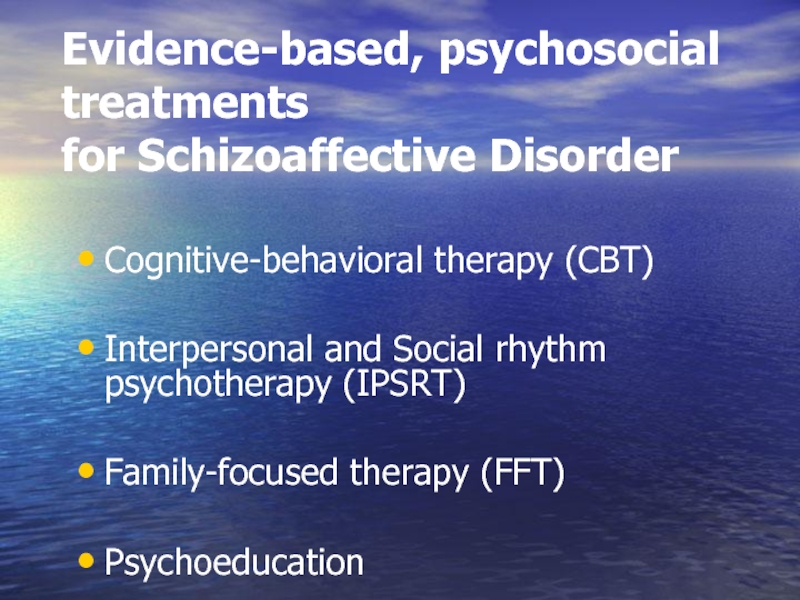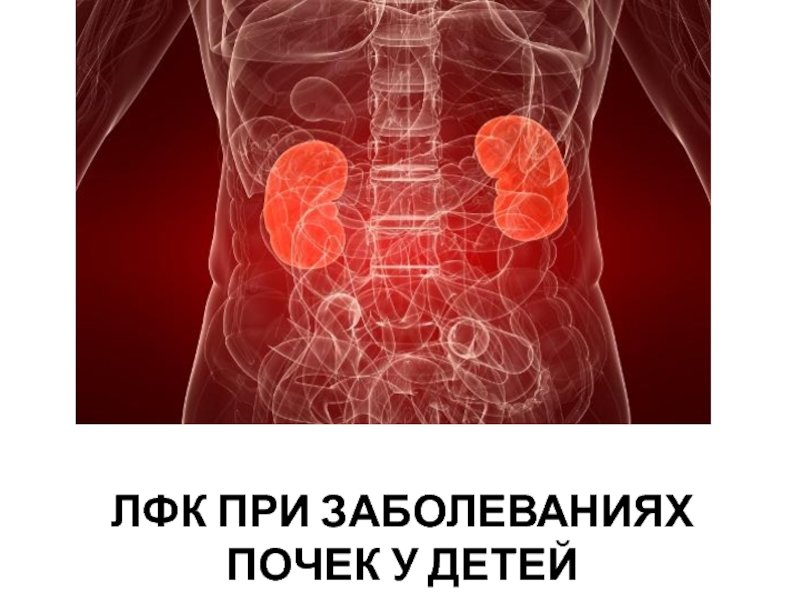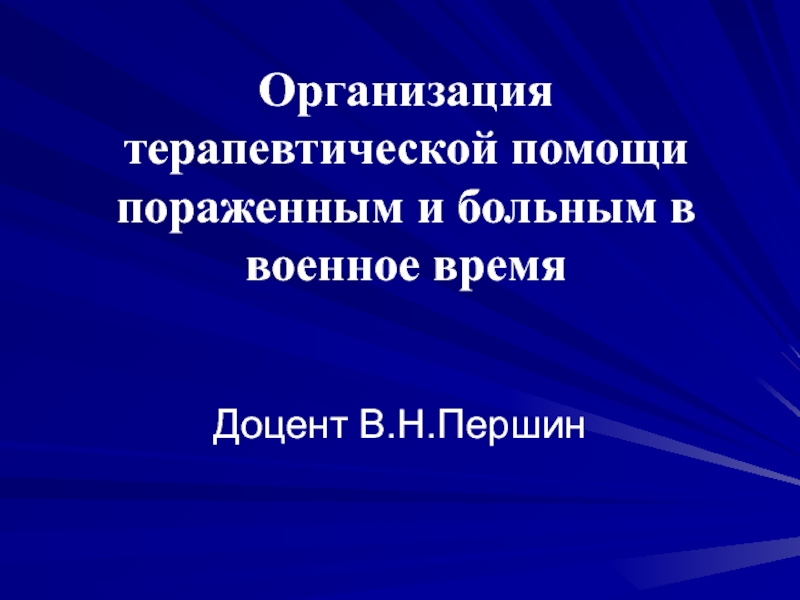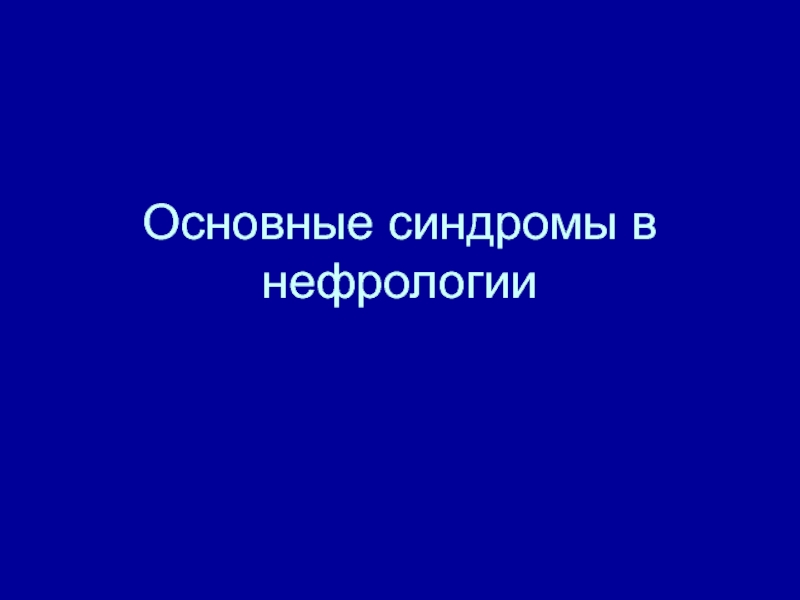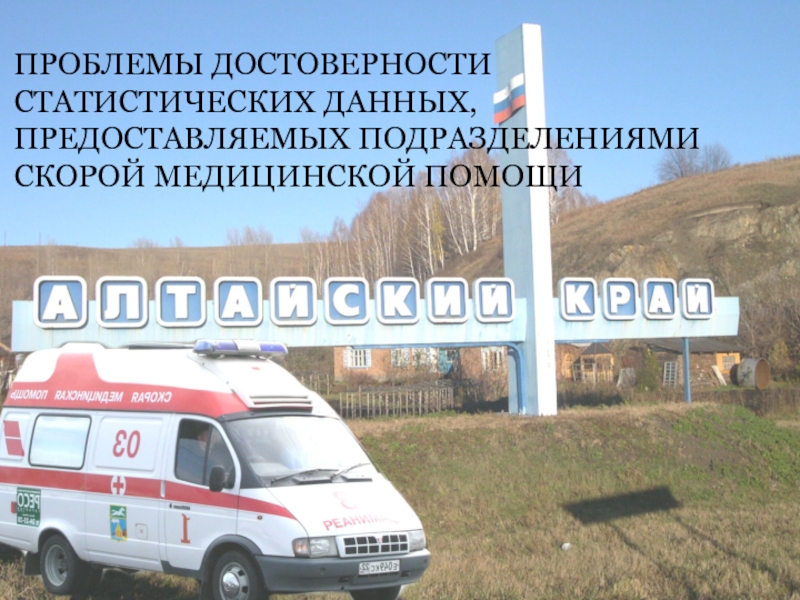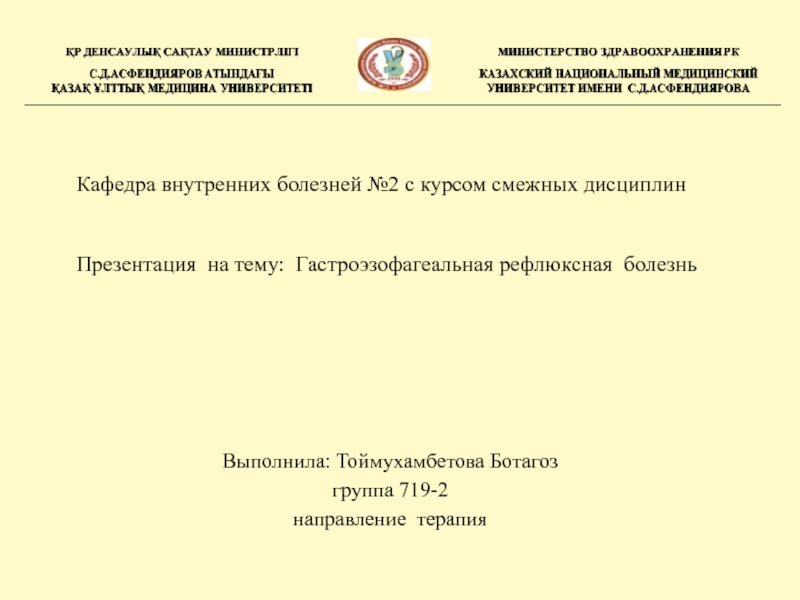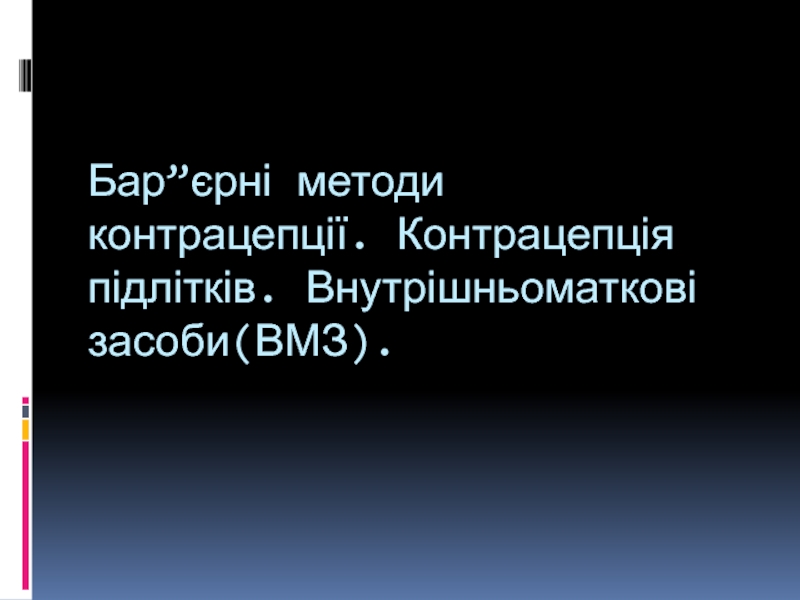- Главная
- Разное
- Дизайн
- Бизнес и предпринимательство
- Аналитика
- Образование
- Развлечения
- Красота и здоровье
- Финансы
- Государство
- Путешествия
- Спорт
- Недвижимость
- Армия
- Графика
- Культурология
- Еда и кулинария
- Лингвистика
- Английский язык
- Астрономия
- Алгебра
- Биология
- География
- Детские презентации
- Информатика
- История
- Литература
- Маркетинг
- Математика
- Медицина
- Менеджмент
- Музыка
- МХК
- Немецкий язык
- ОБЖ
- Обществознание
- Окружающий мир
- Педагогика
- Русский язык
- Технология
- Физика
- Философия
- Химия
- Шаблоны, картинки для презентаций
- Экология
- Экономика
- Юриспруденция
Bipolar disorder презентация
Содержание
- 1. Bipolar disorder
- 2. Bipolar Disorder It is a spectrum of
- 3. Bipolar Disorder may manifest itself only by
- 4. Longitudinal Assessment of the Course of Bipolar
- 5. Subtypes of Bipolar Disorder Bipolar I: Depression
- 6. Bipolar I or II Disorder ? What
- 7. Prevalence Rates and Course Bipolar I Lifetime:
- 8. Prevalence Rates and Course Bipolar II Lifetime:
- 9. Causes
- 10. Genetics
- 11. Hereditary Factors 1st degree relatives have significantly
- 12. Biochemical Hypothesis low level of norepinephrine
- 13. Alterations in Brain Function: Neurotransmission (NT) Model
- 14. Bipolar Brain: Differences in Size Frontal
- 15. The Limbic System
- 16. Bipolar Brain: Activity PET scans: the
- 17. Signs & Symptoms
- 18. Depressive phase - Depressive syndrome sad
- 19. Hypothymia Decreasing speed of Speech
- 20. Major Depressive Episode —Diagnostic Criteria Five or
- 21. Major Depressive Disorder —Diagnostic Criteria Five or
- 22. SUICIDE RISK Must Be Continually Monitored
- 23. Diagnostic Criteria Hypomanic Episode: A. A
- 24. Diagnostic Criteria Hypomanic Episode: 1) inflated
- 25. Diagnostic Criteria Hypomanic Episode: (continued) 4) flight
- 26. Diagnostic Criteria Hypomanic Episode: (continued) 7) excessive
- 27. Manic Episode - Manic syndrome inadequately high
- 28. Euphoria Pressured Speech Hyperactivity
- 29. Diagnostic Criteria Manic Episode: A. A distinct
- 30. Diagnostic Criteria Manic Episode: (continued) C. The
- 31. Diagnostic Criteria Manic Episode: (continued) E. The
- 32. Mixed Episode Rapidly alternating moods (sadness, irritability,
- 33. Dysthymic Disorder Major Depressive Disorder
- 34. Treatment options for bipolar depression Normothymics Psychotherapy Electroconvulsive Therapy (ECT) Antidepressants Antipsychotics
- 35. Medications for Bipolar Disorder Mood Stabilizers
- 36. Lithium Much often recommended treatment for Bipolar
- 37. Side Effects and Toxicity of Lithium Lithium
- 38. Lithium Doesn’t Work? 40% of patients with
- 39. Valproic Acid (Depakote) An anti-epileptic, it is
- 40. Carbamazepine (Tegretol) Superior to lithium for rapid-cycling,
- 41. Blood Monitoring Blood level monitoring required for
- 42. Atypical Antipsychotics: Don’t be afraid of the word “antipsychotic”
- 43. Medications for Bipolar Disorder Second Generation
- 44. Atypical Antipsychotics (AAPs) Olanzapine (Zyprexa) 2.5mg-20mg/day Quetiapine
- 45. Atypical Anti-psychotics No support for use as
- 46. ECT 1] Mania very severe and
- 47. Classic & New Antidepressants Tricyclics, Tetracyclics (TCA)
- 48. SSRIs Dosage Fluoxetine [Prozac] 10-80
- 49. Evidence-based, psychosocial treatments for bipolar disorder Cognitive-behavioral
- 50. Psychoeducation 21 groups sessions of 90 minutes
- 51. Schizoaffective Disorder
- 52. Schizoaffective disorder Endogenic psychosis Mixed symptoms
- 53. Schizoaffective Disorder Difficulty in conceptualization
- 54. schizoaffective disorder patients meets diagnostic criteria for
- 55. Etiology Possible causes of schizoaffective disorder are similar to those of schizophrenia (lust lecture)
- 56. Biologic Theories of Causation Genetic
- 57. Classification Schizoaffective disorder. Depressions type Schizoaffective disorder.
- 58. Diagnostic Criteria for Schizoaffective Disorder At least
- 59. Diagnostic Criteria for Schizoaffective Disorder Delusions or
- 60. Signs and symptoms of schizoaffective disorder may
- 61. Treatment Normothymics are a mainstay of
- 62. Treatment Antipsychotics (neuroleptics) to treat psychotic symptoms,
- 63. Treatment Antidepressants. When depression is the
- 64. Evidence-based, psychosocial treatments for Schizoaffective Disorder
Слайд 108/05/2018
Bipolar Affective Disorder
is an endogenous disease characterized by alternation of phases,
Слайд 2Bipolar Disorder
It is a spectrum of affective episodes including:
Major depressive episode
Manic
Mixed episode
Hypomanic episode
Rapid cycling
Bipolar I Disorder
Bipolar II Disorder
Bipolar III Disorder
Cyclothymia
Слайд 3Bipolar Disorder
may manifest itself only by its maniac or depressive phases
In any type of the course there is no progression and destruction of the personality.
Слайд 4Longitudinal Assessment of the Course of Bipolar Disorders
Polarity of Symptoms
Euthymia
Depression
Mania
Subsyndromal
Depression
Depression
Hypomania
Слайд 5Subtypes of Bipolar Disorder
Bipolar I: Depression with Classic Mania
Bipolar II:
Bipolar III: Antidepressant Associated Hypomania
Слайд 6Bipolar I or II Disorder ?
What is the difference?
Bipolar I
1+ manic
May have other mood episodes
Bipolar II
1 + major depressive episodes AND
1 + hypomanic episodes
Never manic or mixed episode
Слайд 7Prevalence Rates and Course
Bipolar I
Lifetime: 0.4-0.8 %
= in men and women
Men>manic
Women>depressive episodes
Women>rapid cycling
age of manifestation = 20
Recurrent course
60-70% of manic episodes occur before or after a depressive episode
Слайд 8Prevalence Rates and Course
Bipolar II
Lifetime: 0.5%
May be more common in women
Men>hypomanic than depressive episodes
Women>depressive than hypomanic episodes
Women>rapid cycling
60-70% of hypomanic episodes occur before or after a depressive episode
Interval between episodes decrease with age
Less data overall
Слайд 11Hereditary Factors
1st degree relatives have significantly higher rates
Twin and adoption studies
May reflect external factors
Слайд 12Biochemical Hypothesis
low level of norepinephrine
Dopamine implicated in the study of mania
Serotonin
Слайд 13Alterations in Brain Function: Neurotransmission (NT) Model
Catecholamine hypothesis:
Same hypothesis for schizophrenia
Depressive symptoms: NT activity deficits
Mania and psychosis: hyper NT activity
NTs: Serotonin, GABA, norepinephrine, dopamine
Alternative hypothesis
NT dysregulation leads to loss of mood stabilization
Слайд 14
Bipolar Brain: Differences in Size
Frontal cortex shrinks
Enlarged ventricles
Possible association with tissue
Enlarged amygdala
Part of limbic system: memory, emotions, motivation, fear
From left: view of a normal brain; patient with bipolar disorder has enlarged ventricles; bright white spots of hyperintensity associated with bipolar illness.
Слайд 16Bipolar Brain: Activity
PET scans: the individual shifts from depression to mania
Blue and green: low levels of brain activity
Red, orange, and yellow: high levels of brain activity
Слайд 18Depressive phase - Depressive syndrome
sad and melancholic mood
a delayed
a motor inhibition
Слайд 19
Hypothymia
Decreasing speed of Speech Hypoactivity
3 Signs in 3 Days
The Unmistakable Triad
Слайд 20Major Depressive Episode
—Diagnostic Criteria
Five or more of the following symptoms are
Слайд 21Major Depressive Disorder
—Diagnostic Criteria
Five or more of the following symptoms are
Слайд 22SUICIDE RISK
Must Be Continually Monitored
Suicide completion rates in patients with
Presence of suicidal or homicidal ideation, intent, plans
Access to means
Psychotic features, severe anxiety
Substance abuse
History of previous attempts
Family history of suicide
Слайд 23Diagnostic Criteria
Hypomanic Episode:
A. A distinct period of abnormally and persistently
B. During the period of the mood disturbance, three or more of the following symptoms (four if the mood is only irritable):
Слайд 24Diagnostic Criteria
Hypomanic Episode:
1) inflated self-esteem or grandiosity
2) decreased need for
3) more talkative than usual or pressure to keep talking
Слайд 25Diagnostic Criteria
Hypomanic Episode: (continued)
4) flight of ideas or subjective experience that
5) distractibility (attention too easily drawn to unimportant external stimuli)
6) increase in goal-directed activity (either socially, at work or school, or sexually) or psychomotor agitation
Слайд 26Diagnostic Criteria
Hypomanic Episode: (continued)
7) excessive involvement in pleasurable activities that have
APA Diagnostic and Statistical Manual. 1994
Слайд 27Manic Episode - Manic syndrome
inadequately high spirits
acceleration of associative processes
Слайд 28
Euphoria
Pressured Speech Hyperactivity
3 Signs in 3 Days
The Unmistakable Triad of Manic
Слайд 29Diagnostic Criteria
Manic Episode:
A. A distinct period of abnormally and persistently elevated,
B. Same as for hypomanic episode
Слайд 30Diagnostic Criteria
Manic Episode: (continued)
C. The symptoms do not meet criteria for
D. The mood disturbance is severe to cause marked impairment in occupational functioning or in usual social activities or relationships with others, or to necessitate hospitalization to prevent harm to self or others, or there are psychotic symptoms.
Слайд 31Diagnostic Criteria
Manic Episode: (continued)
E. The symptoms are not connected with the
Слайд 32Mixed Episode
Rapidly alternating moods (sadness, irritability, euphoria) accompanied by criteria for
Duration of 1 week.
includes agitation, insomnia, appetite deregulation, psychotic features, and suicidal thinking.
Слайд 33Dysthymic Disorder
Major Depressive Disorder
Cyclothymic Disorder
Bipolar I Disorder
Bipolar II Disorder
Слайд 34Treatment options for bipolar depression
Normothymics
Psychotherapy
Electroconvulsive Therapy (ECT)
Antidepressants
Antipsychotics
Слайд 35Medications for Bipolar Disorder
Mood Stabilizers
Divalproex DR Divalproex ER
Carbamazepine ER
Lamotrigine
Lithium - M
Depakote Depakote ER
Equetro
Lamictal
Eskalith, Lithobid
Слайд 36Lithium
Much often recommended treatment for Bipolar Disorder
60-80% success in reducing acute
issue of non-compliance medication, side effects, and relapse rate with its use are being examined.
Same drugs are used with Bipolar I and II- studies have been inclusive as to which drug might be better for BP II
Слайд 37Side Effects and Toxicity of Lithium
Lithium demonstrates a narrow therapeutic window-
Are related to plasma concentration levels, so constant blood monitoring is key- that is why some doctors prefer Depakote
Higher concentrations Of Lithium ( 1.0 mEq/L and up produce side effects, higher than 2 mEq/L can be serious or fatal)
Symptoms can be neurological, gastrointestinal, weight gain, memory difficulty, cardiovascular violations
Not advised to take during pregnancy, affects fetal heart development.
Слайд 38Lithium Doesn’t Work?
40% of patients with Bipolar disorder are resistant to
Therefore, we must consider alternative agents for treatment
Слайд 39Valproic Acid (Depakote)
An anti-epileptic, it is probably the more often used
Best for rapid cycling and acute mania especially mixed episodes
Side effects include sedation, lethargy,tremor, metabolic liver changes
Can also be used for mood, and personality disorders
Слайд 40Carbamazepine (Tegretol)
Superior to lithium for rapid-cycling, regarded as a second-line treatment
Side effects may include GI upset, sedation, ataxia, blurred vision and cognitive effects.
GI upset can be decreased by taking with food.
First-line for mixed episodes
Слайд 41Blood Monitoring
Blood level monitoring required for Tegretol and Depakote.
Weekly and then
Toxicity- elevated serum level (overdose) can lead to death
Toxic Effects
Tegretol- neurologic and cardiac malfunctions
Depakote- somnolence and coma
Слайд 43Medications for Bipolar Disorder
Second Generation Antipsychotics
Aripiprazole - M
Olanzapine - M
Quetiapine
Risperidone
Ziprasidone
Abilify
Zyprexa
Seroquel
Risperidal
Geodon
Слайд 44Atypical Antipsychotics (AAPs)
Olanzapine (Zyprexa) 2.5mg-20mg/day
Quetiapine (Seroquel) 12.5-600mg/day
Risperidone (Risperdal) 0.25mg-6mg/d
Ziprasidone (Geodon) 20-160mg
Aripiprazole (Abilify) 5-30mg a day
listed in order of rate of weight gain/sedation
Слайд 45Atypical Anti-psychotics
No support for use as primary first-line agents
4 types that
Clozapine is effective, yet not readily used due to potential serious side effects
Olanzapine is approved for short-term use in acute mania
Слайд 46ECT
1] Mania very severe and not responding to medications.
2] Patient prefers
3] Pregnant
4] Psychotic signs prominent.
high suicidal risk
Слайд 47Classic & New Antidepressants
Tricyclics, Tetracyclics (TCA)
5-HT Reuptake Inhibitors (SSRI)
Fluoxetine (& R-FLX),
NE/5-HT Reuptake Inh. (SNRI)
Venlafaxine, Milnacipran, Duloxetine
DA/NE Reuptake Inh.: Bupropion
5-HT Rec. Modulators: Trazodone, Nefazadone
Pre, Post-Synaptic agonist/antag: Mirtazapine
MAO inhibitors: (reversible & not)
Слайд 48SSRIs Dosage
Fluoxetine [Prozac] 10-80 mg/d
Paroxetine [Paxil]
Sertraline [Zoloft] 25-200 mg/d
Fluvoxamine [Luvox] 50-300 mg/d
Citalopram [Celexa] 20-50 mg/d
Initial response 2-4 wks, if not better after 3-4 wks ↑dose
Слайд 49Evidence-based, psychosocial treatments
for bipolar disorder
Cognitive-behavioral therapy (CBT)
Interpersonal and Social rhythm psychotherapy
Family-focused therapy (FFT)
Psychoeducation
Слайд 50Psychoeducation
21 groups sessions of 90 minutes each
Topics include:
Awareness of the disorder
Symptoms, etiology, triggers, course
Drug Adherence (7 sessions)
Review of medications, blood tests, alternative therapies
Avoiding substance abuse (1 session)
Early Detection of New Episodes (3 sessions)
Regular habits and stress management (4 sessions)
Includes problem-solving strategies
Слайд 52Schizoaffective disorder
Endogenic psychosis
Mixed symptoms of schizophrenia and mood disorder (manic or
Intense periods of symptoms and then remission (episodic course)
Слайд 53
Schizoaffective Disorder
Difficulty in conceptualization
Risk for suicide (attempts in 23 to 42%)
Less
Rare in children
More common in women, but developed later
Слайд 54schizoaffective disorder
patients meets diagnostic criteria for both schizophrenia and an affective
Слайд 55Etiology
Possible causes of schizoaffective disorder are similar to those of schizophrenia
(lust
Слайд 56
Biologic Theories of Causation
Genetic predisposition
Neuropathologic changes
Overactivity of dopamine system
Positive symptoms of
Many medications are dopamine antagonists
Dopamine agonists such as amphetamine mimic psychosis
Слайд 57Classification
Schizoaffective disorder. Depressions type
Schizoaffective disorder.
Manic type
Schizoaffective disorder.
Mixed
Слайд 58Diagnostic Criteria for Schizoaffective Disorder
At least two symptoms of psychosis from
Слайд 59Diagnostic Criteria for Schizoaffective Disorder
Delusions or hallucinations have occurred for at
During the period of active illness, the individual meets criteria for one of the following mood disturbances: Major depressive episode, manic episode , mixed episode.
The symptoms are not caused by a biologically active substances such as drugs, alcohol, adverse reaction to a medication or somatic illness.
Слайд 60Signs and symptoms of schizoaffective disorder may include
Strange or unusual thoughts
Paranoid thoughts and ideas
Delusions ideas
Hallucinations, such as verbal
Unclear or confused thoughts (disorganized thinking)
Manic mood or a sudden increase in energy and behavioral displays that are out of character
Irritability and poor temper control
Thoughts of suicide or homicide
Problems with attention and memory
Lack of concern about hygiene
Changes in energy and appetite
Sleep disturbances,
such as difficulty falling asleep or staying asleep
Слайд 61 Treatment
Normothymics are a mainstay of treatment for bipolar disorders and would
-lithium,
-valproate (Depakote)
-carbamazepine (Tegretol)
Слайд 62 Treatment
Antipsychotics (neuroleptics)
to treat psychotic symptoms, such as delusions and hallucinations.
paliperidone (Invega)
clozapine
risperidone (Risperdal)
olanzapine (Zyprexa).
Слайд 63 Treatment
Antidepressants.
When depression is the main mood disorder, antidepressants
Fluoxetine [Prozac]
Paroxetine [Paxil] 10-50 mg/d
Sertraline [Zoloft] 25-200 mg/d
Fluvoxamine [Luvox] 50-300 mg/d
Citalopram [Celexa] 20-50 mg/d
Слайд 64Evidence-based, psychosocial treatments
for Schizoaffective Disorder
Cognitive-behavioral therapy (CBT)
Interpersonal and Social rhythm psychotherapy
Family-focused therapy (FFT)
Psychoeducation
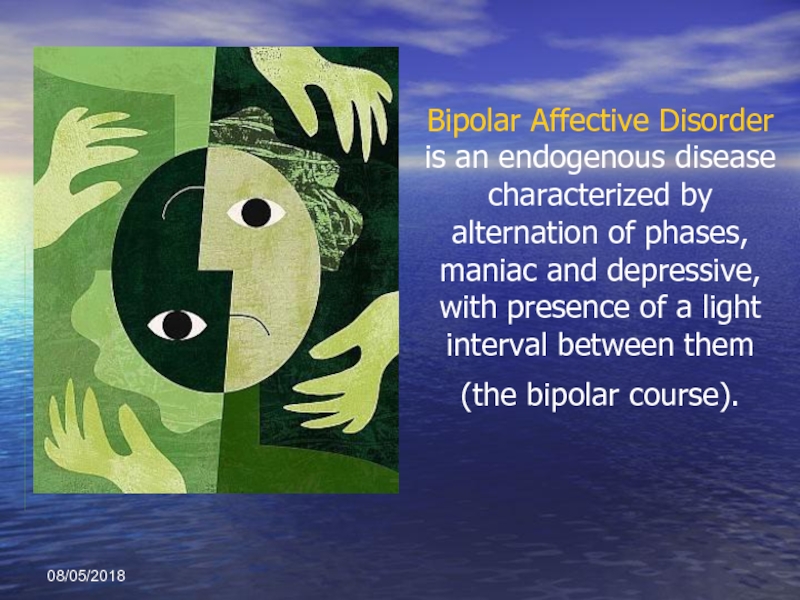
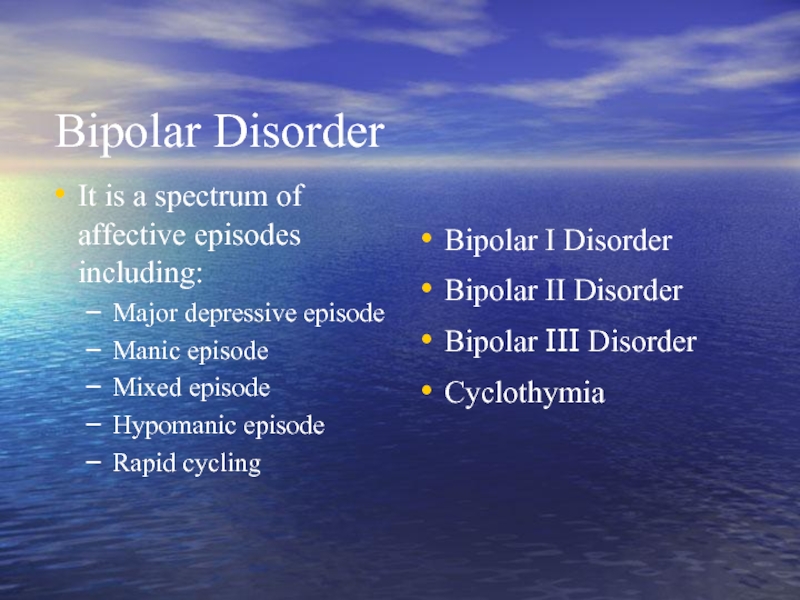
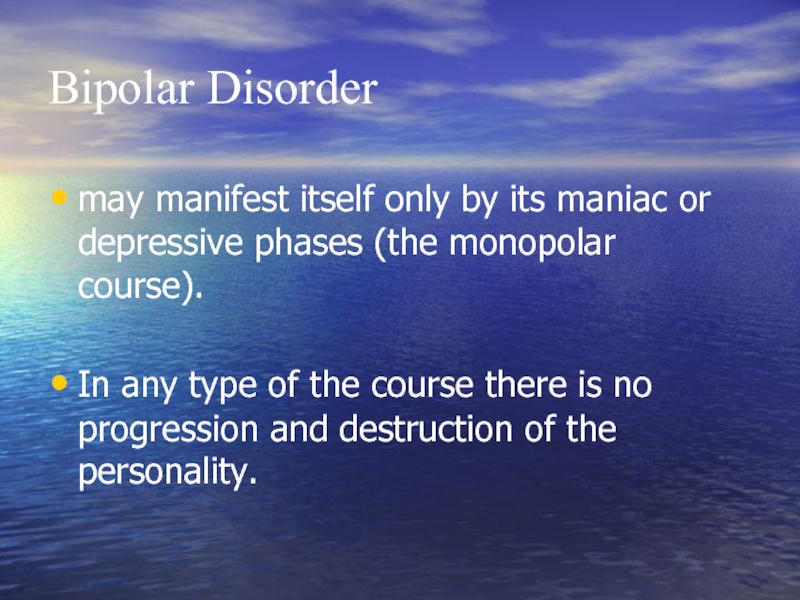
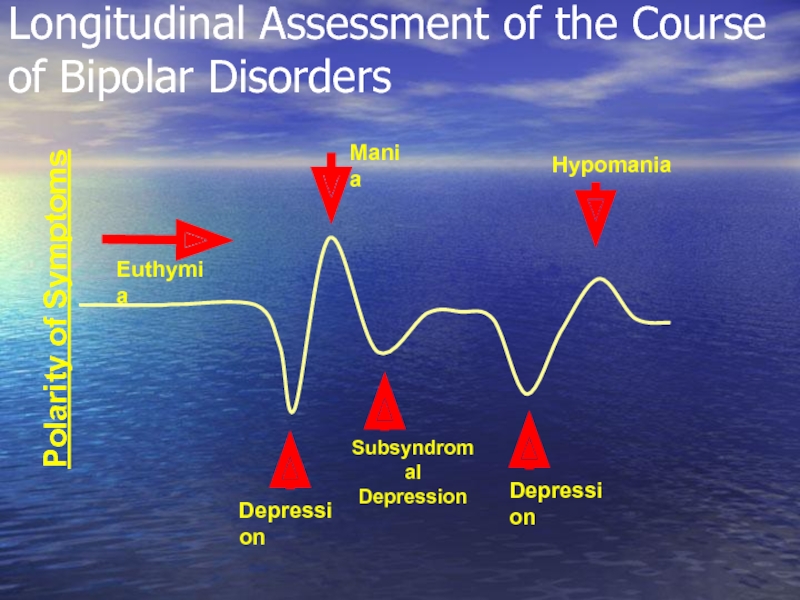
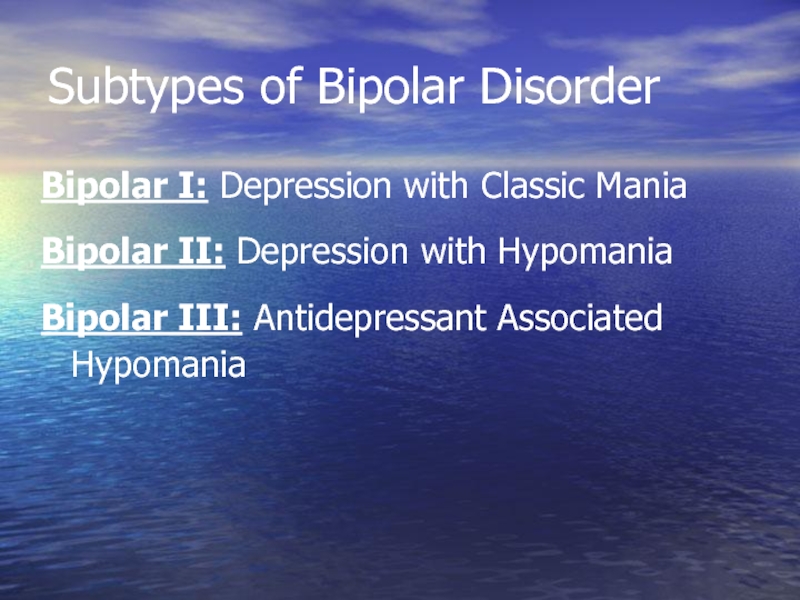
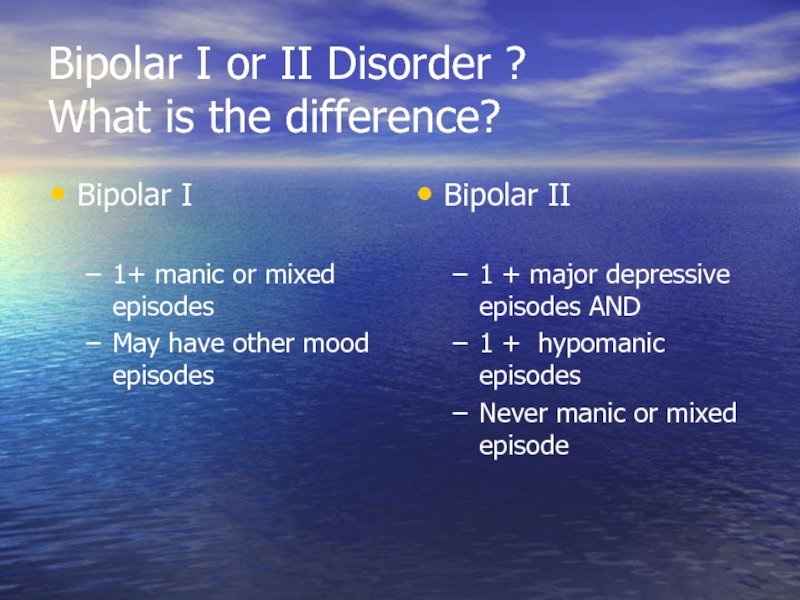
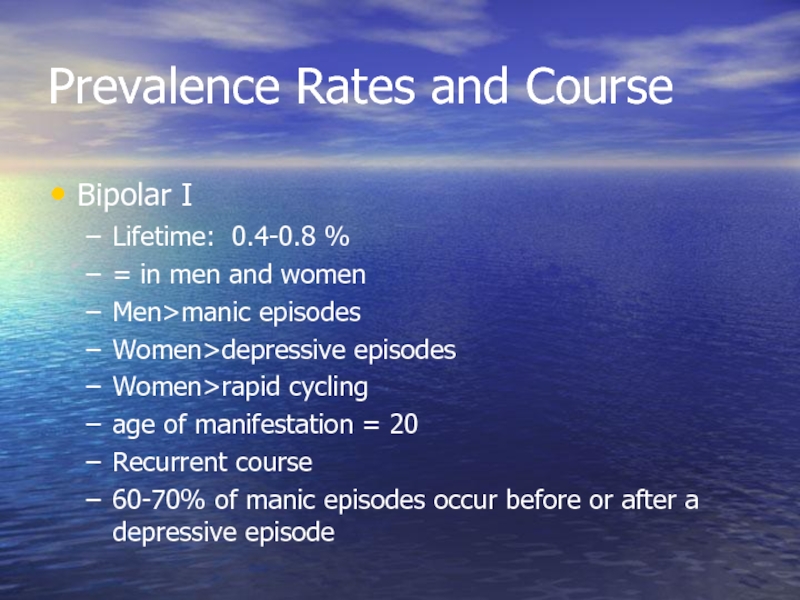

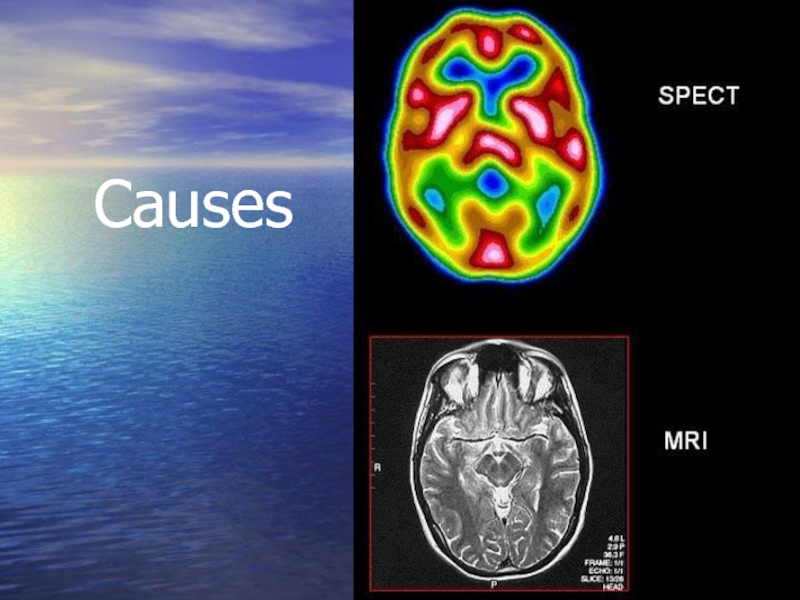
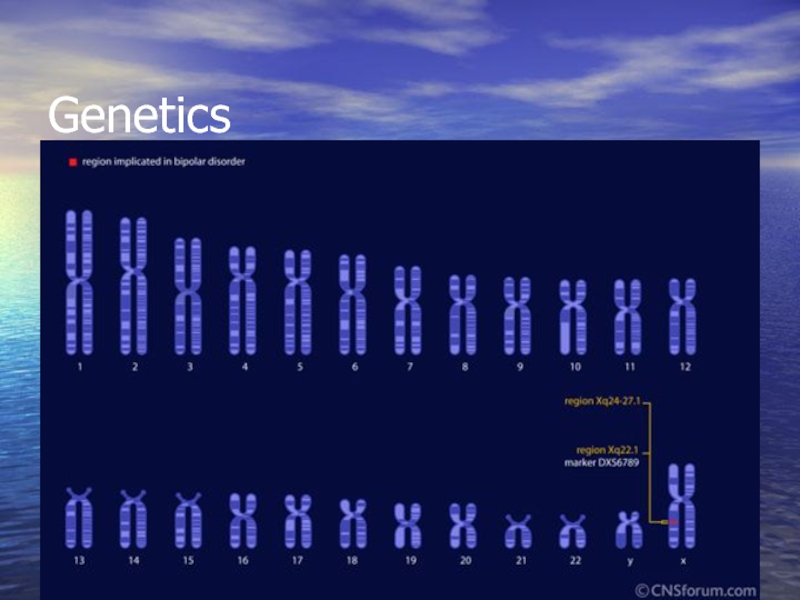
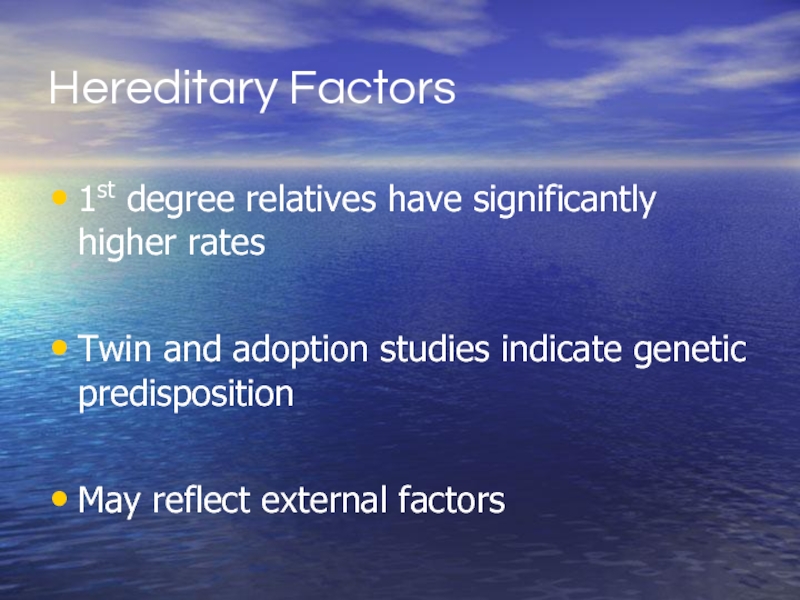
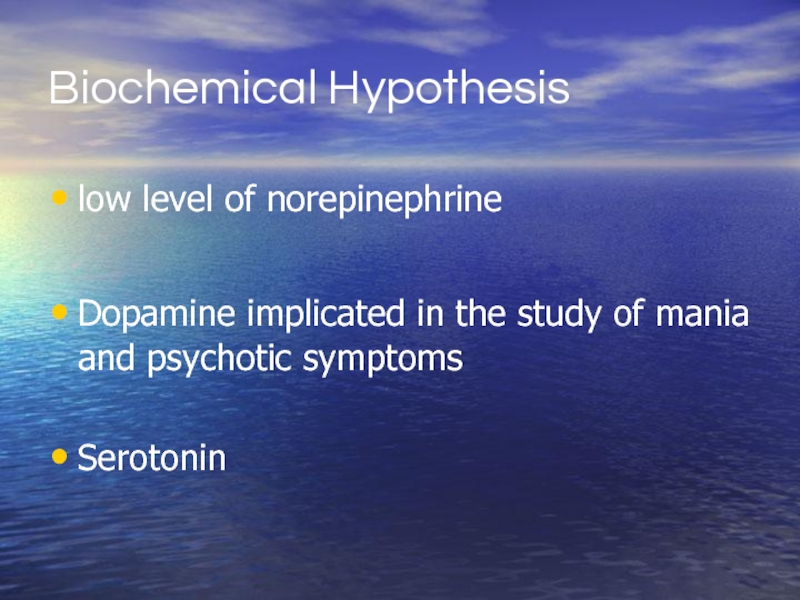
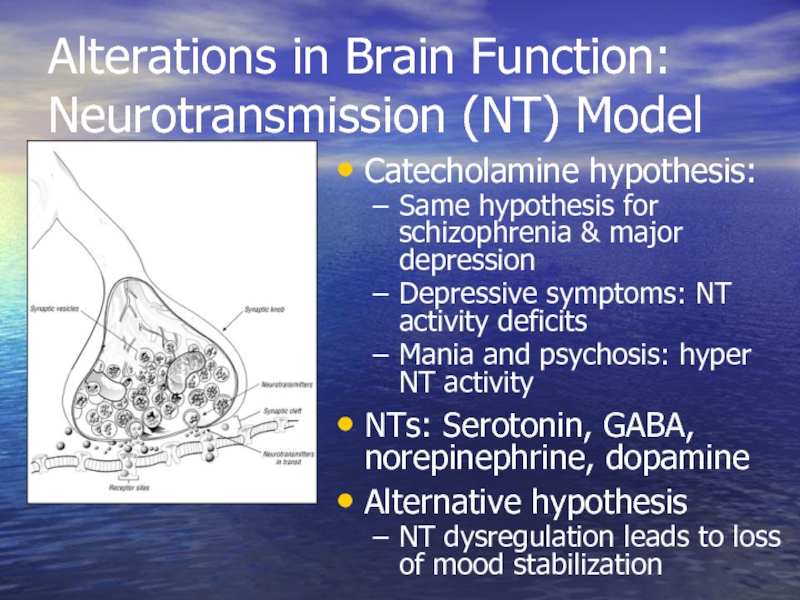
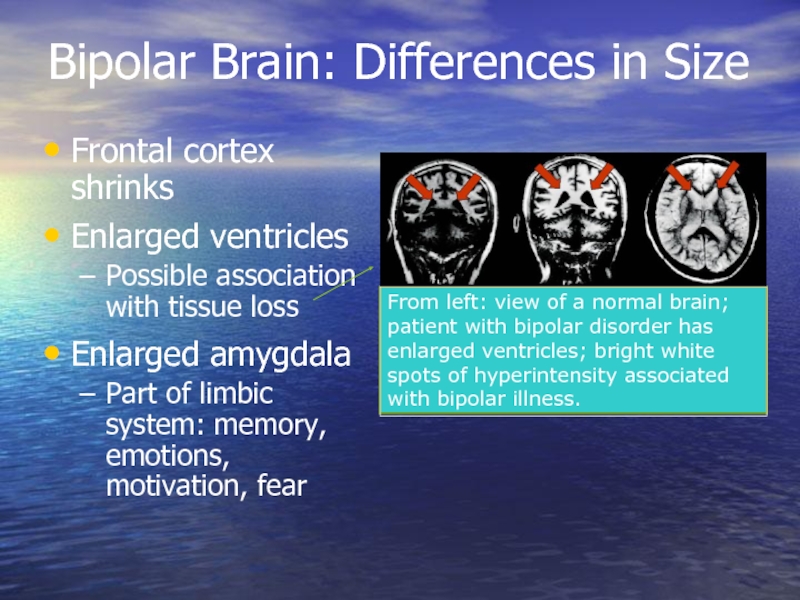
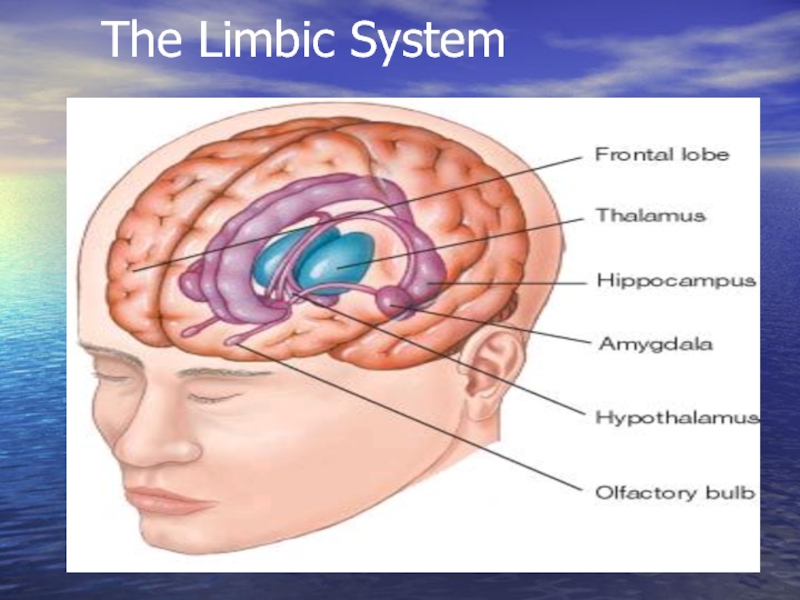
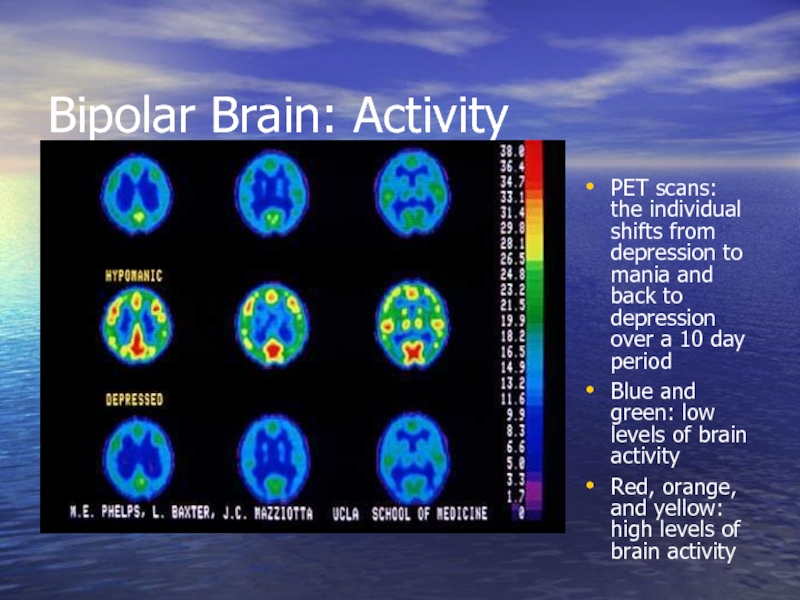
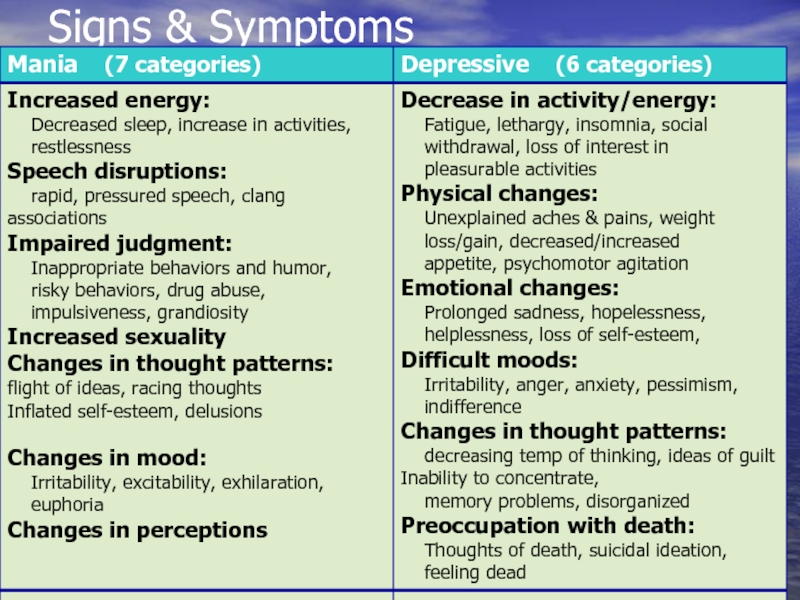
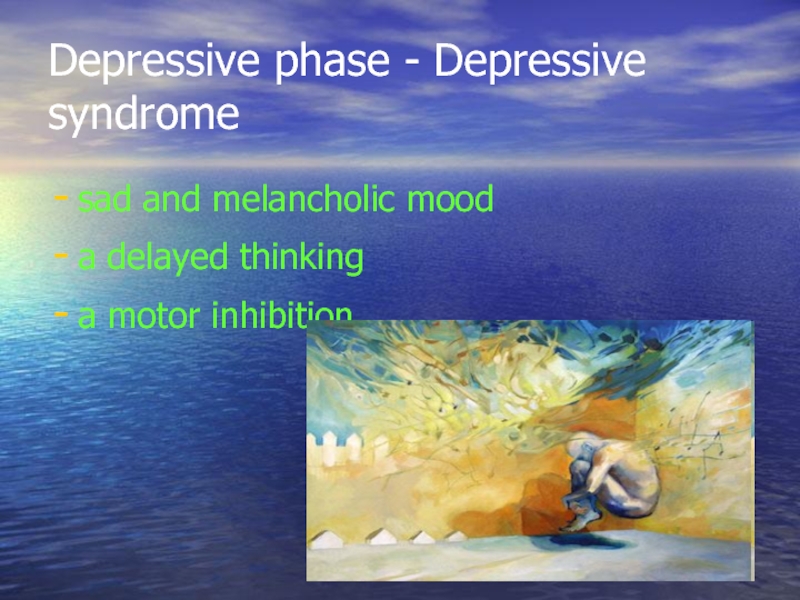
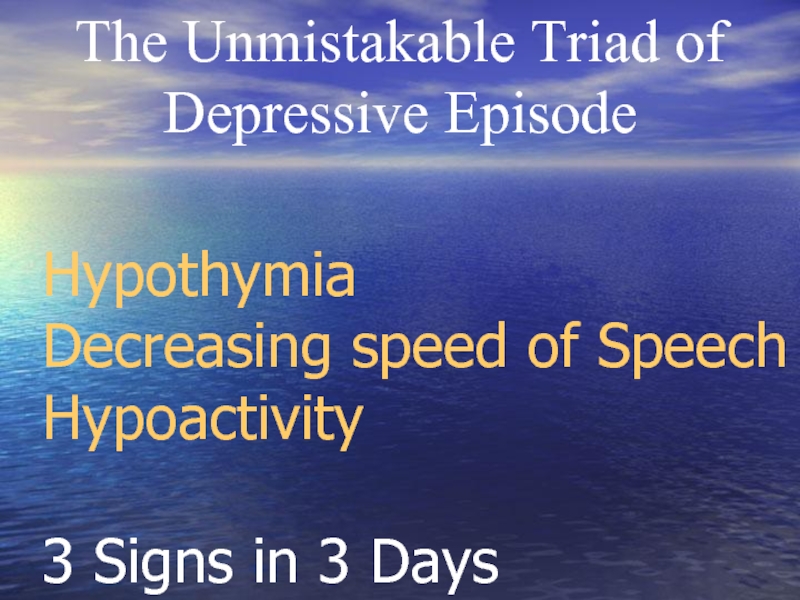
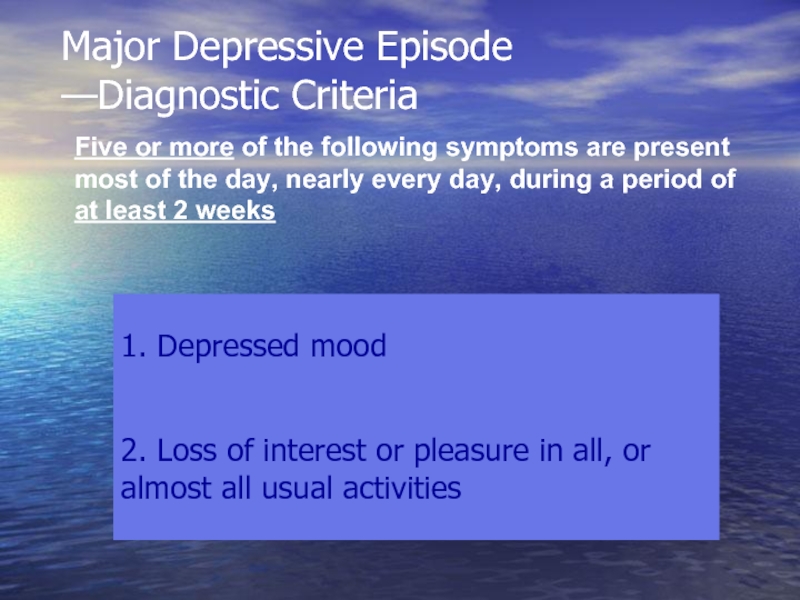
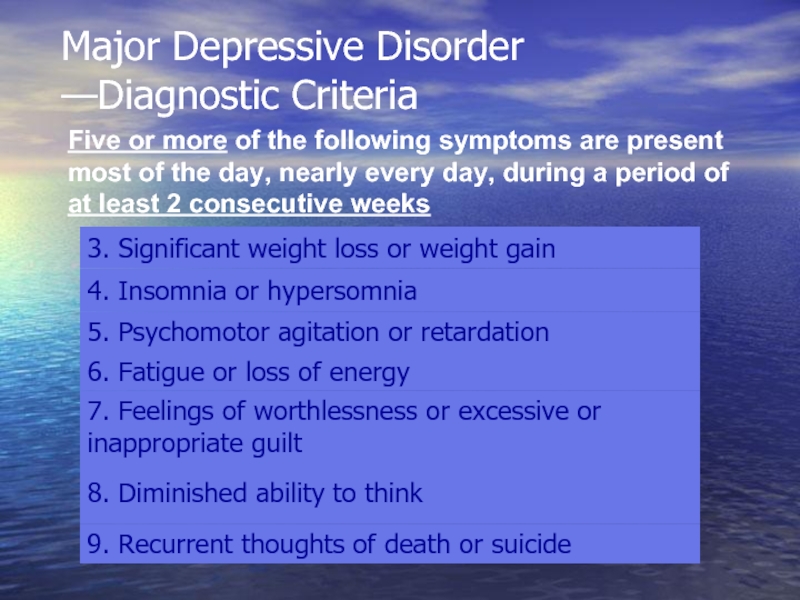
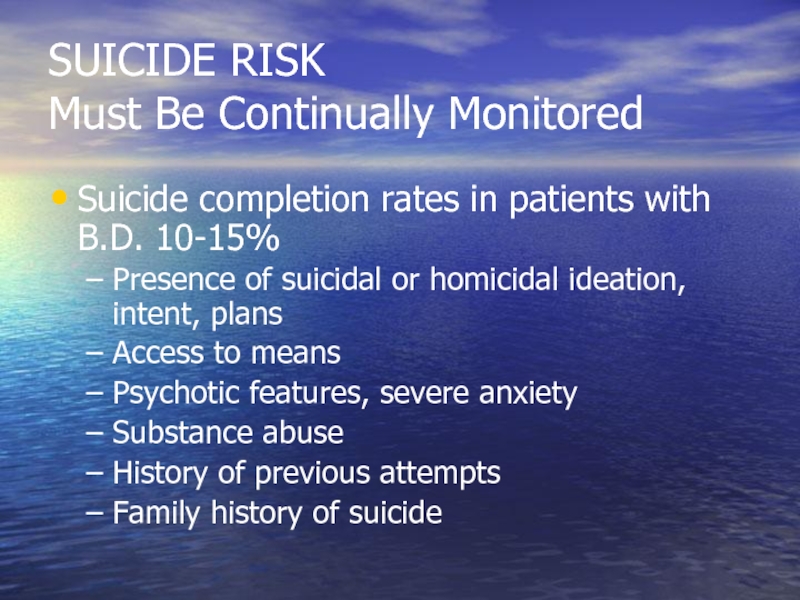
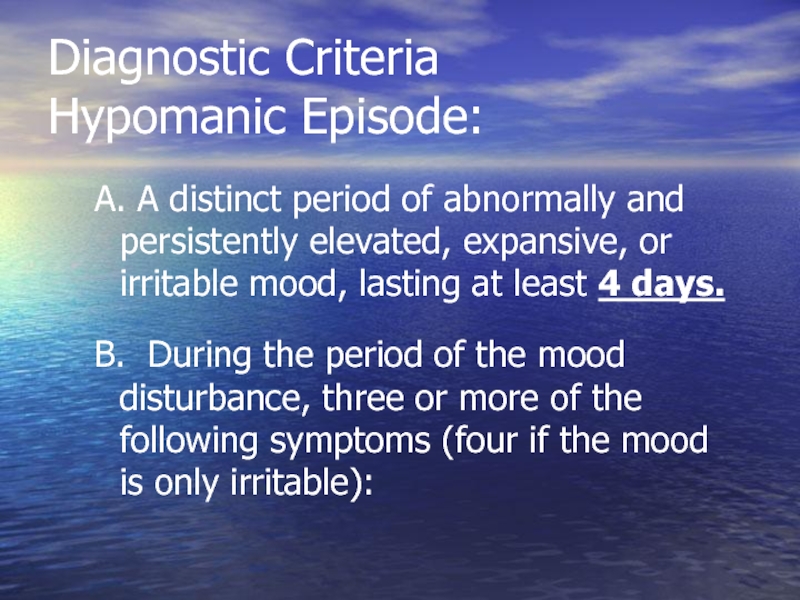
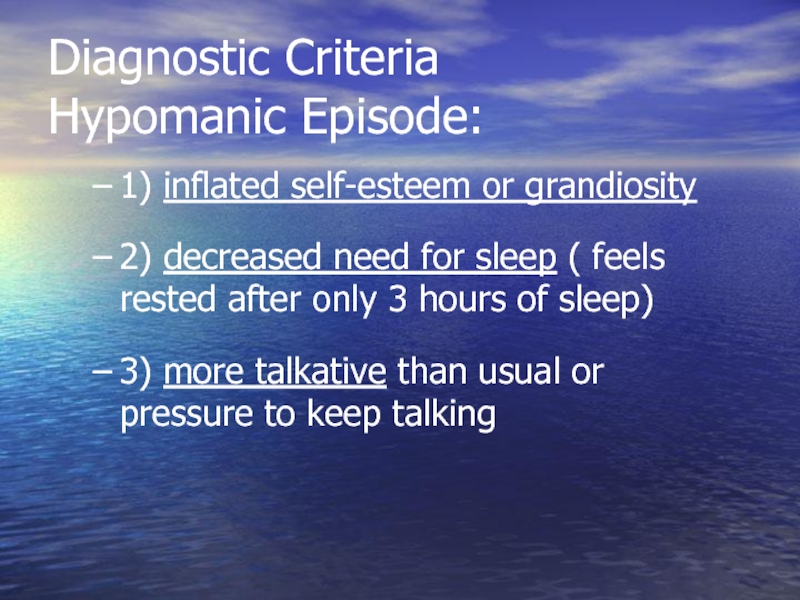
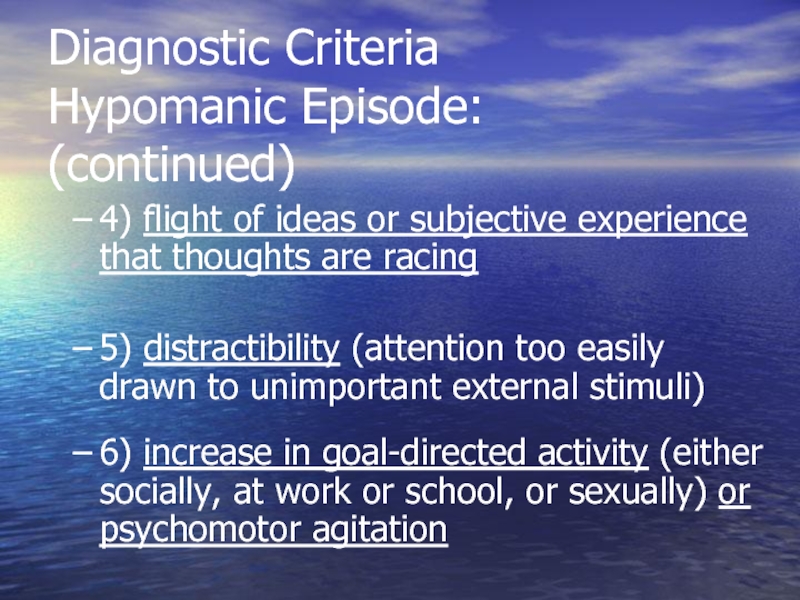
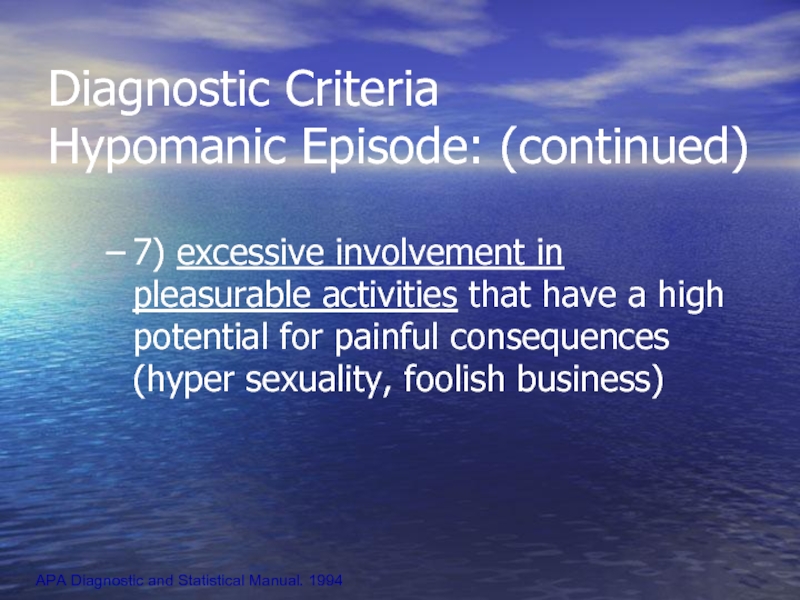
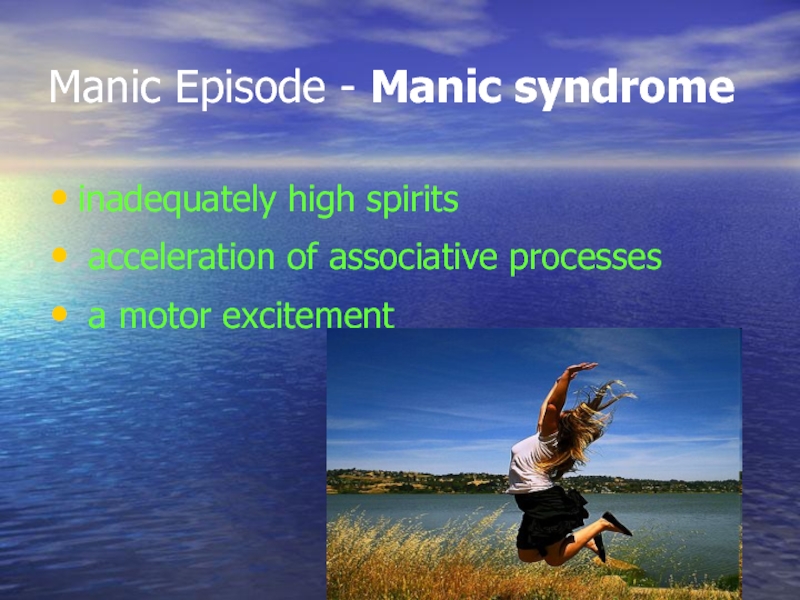
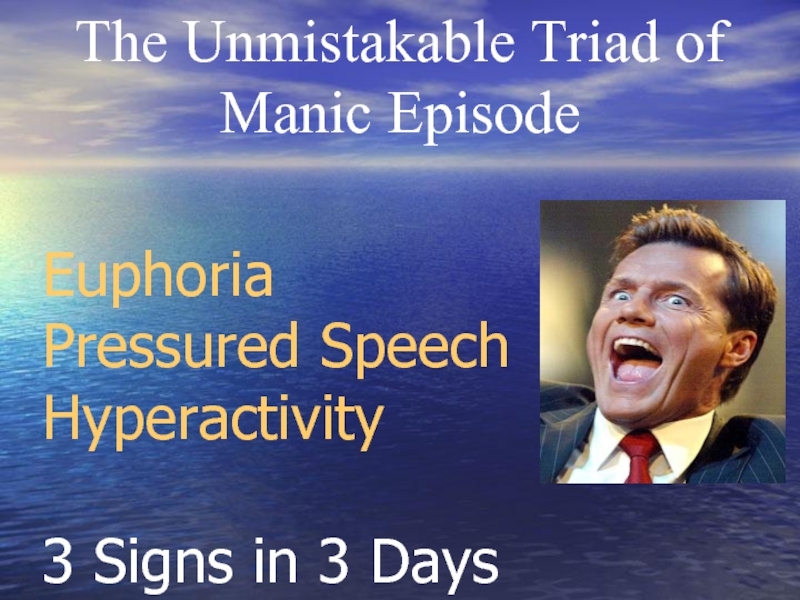
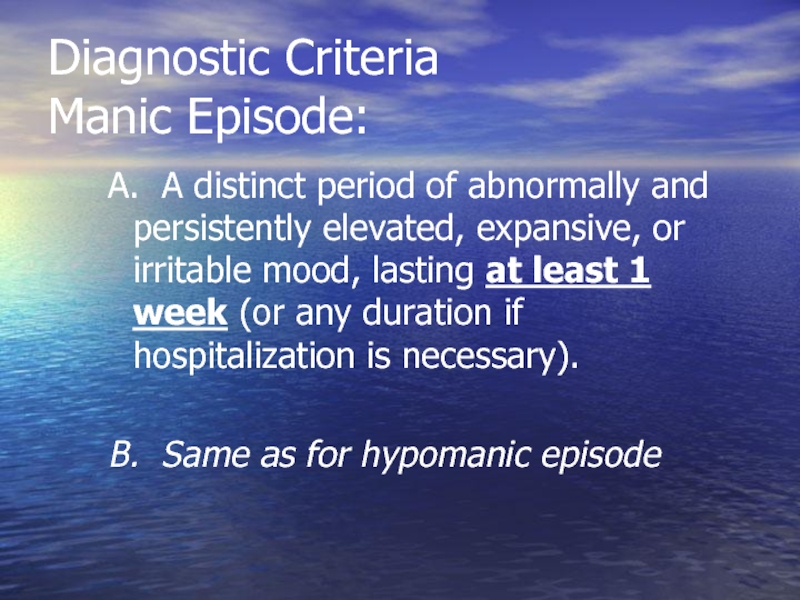
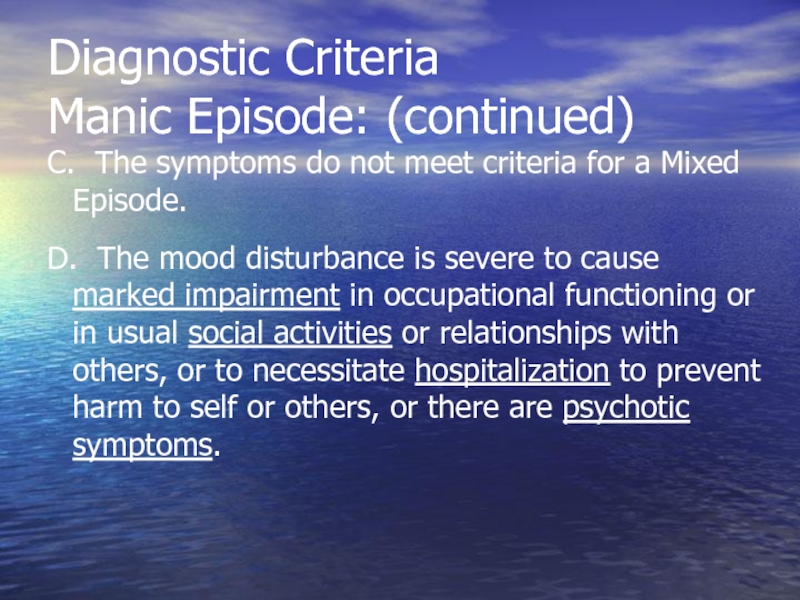
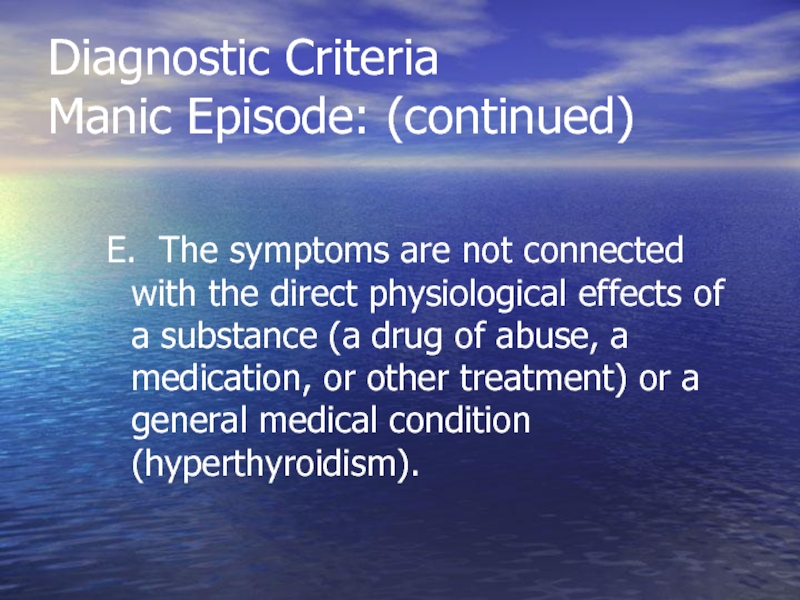
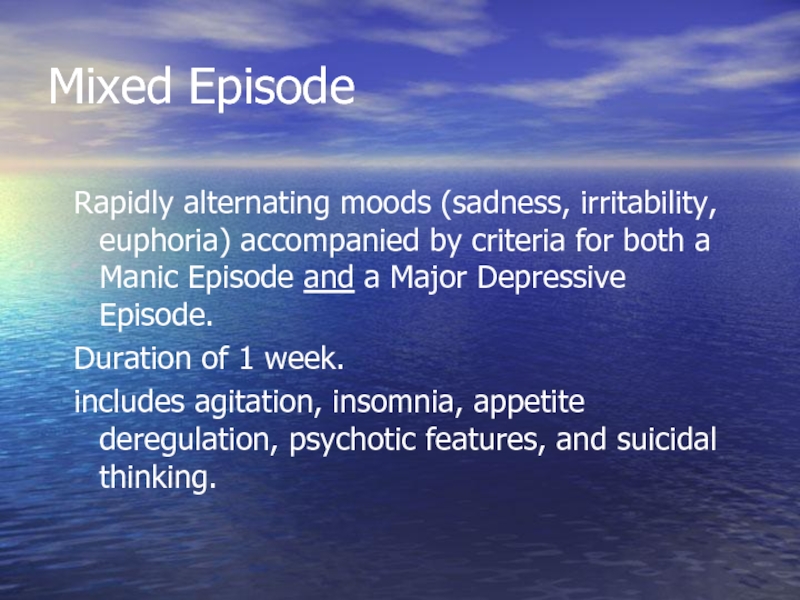
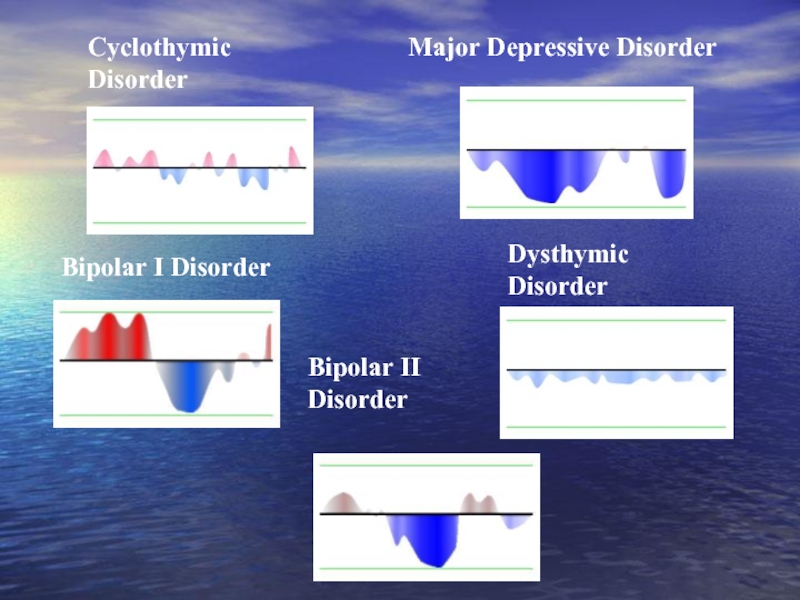
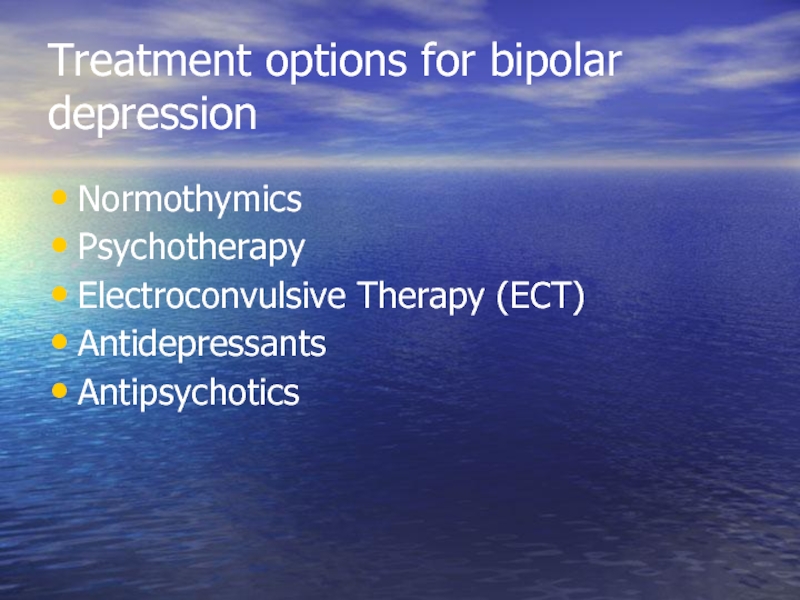
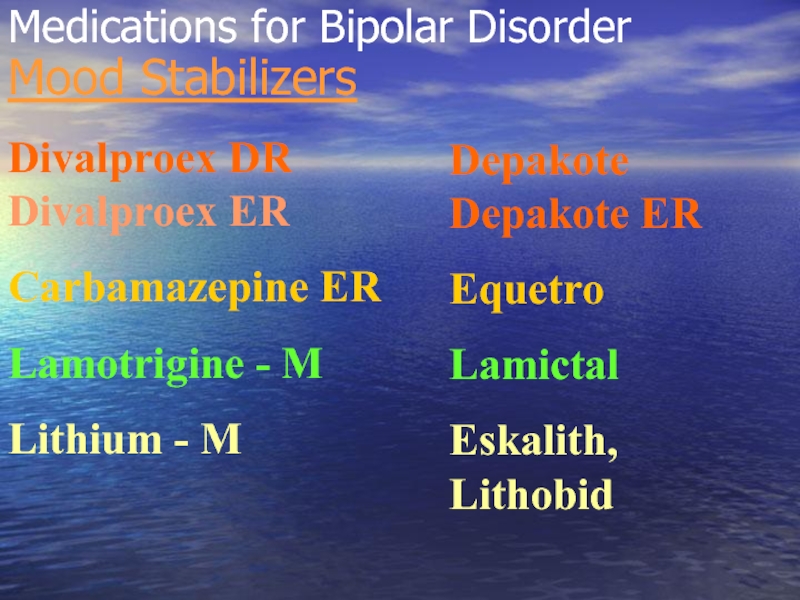
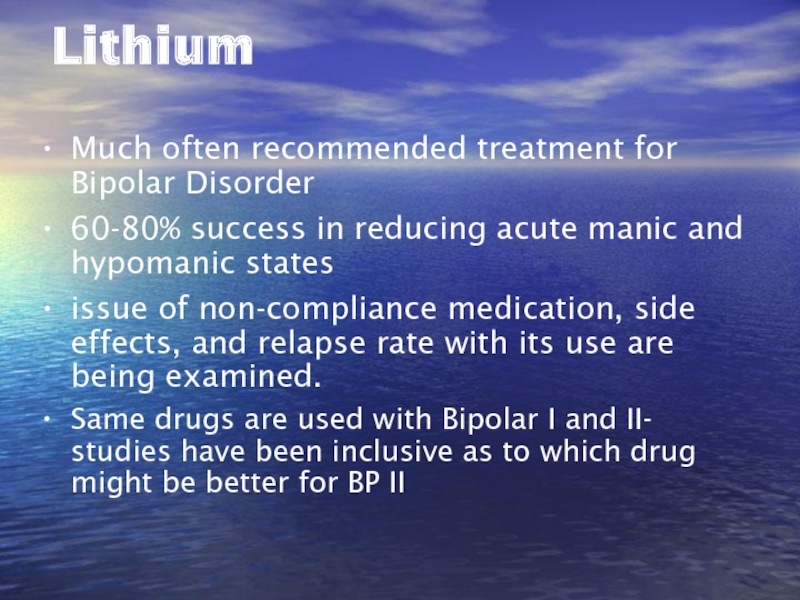
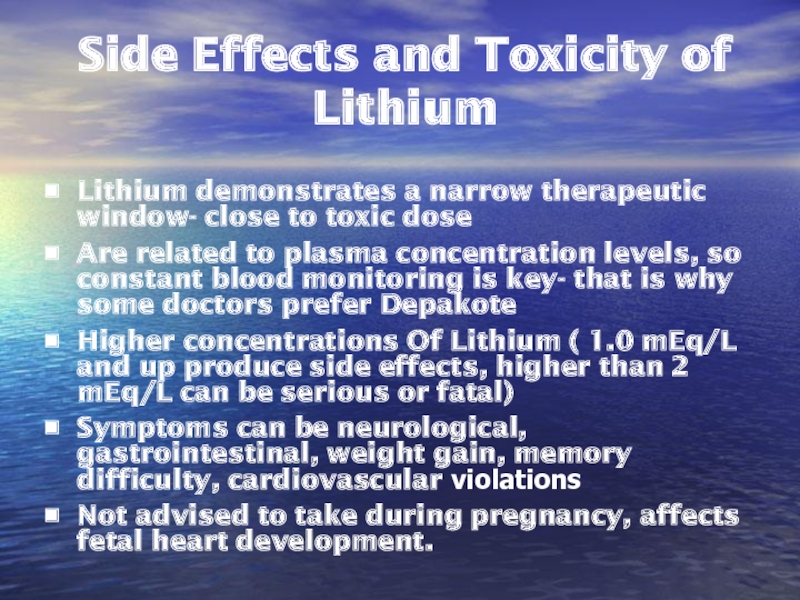
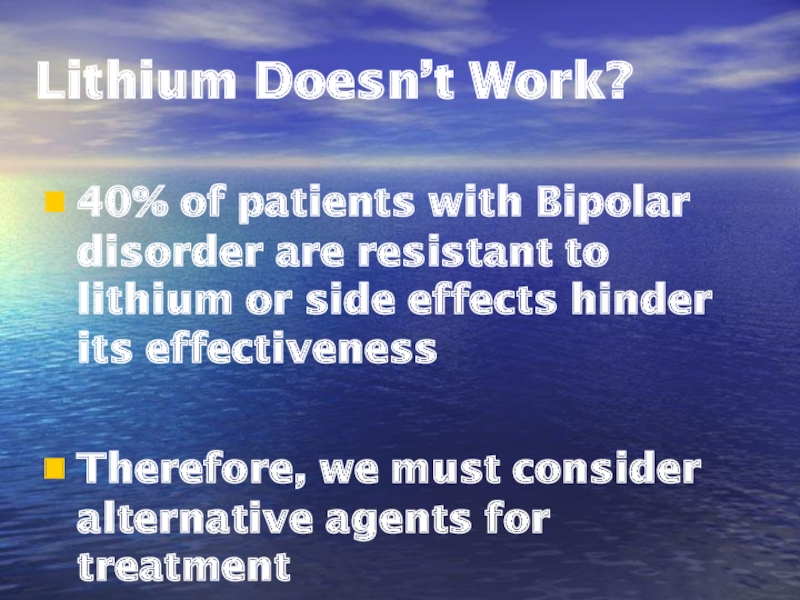
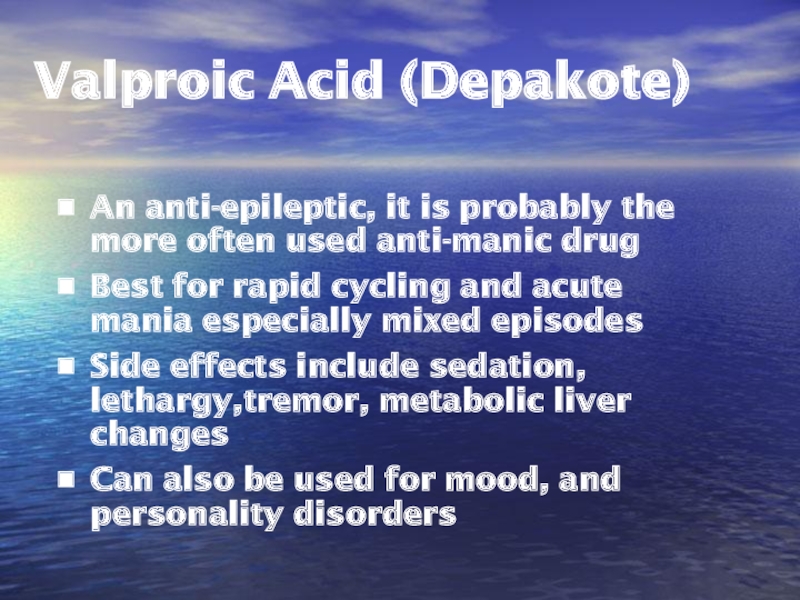
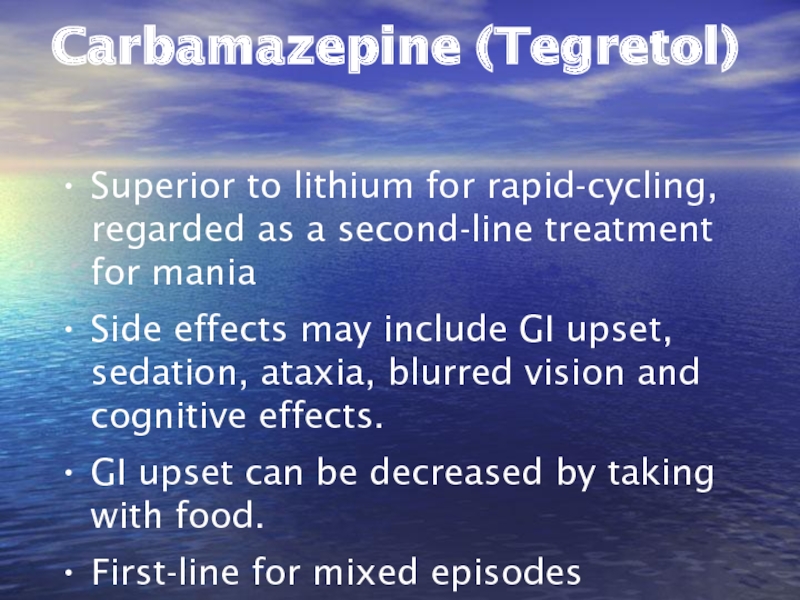
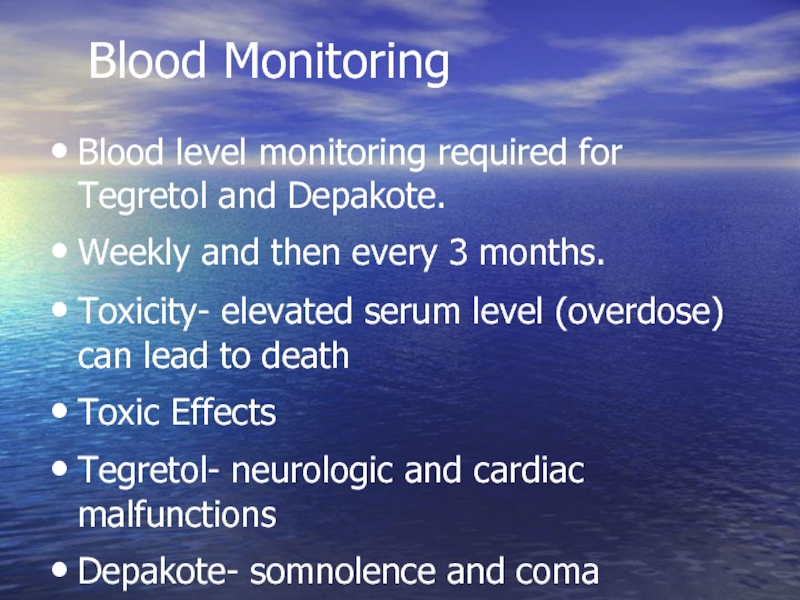
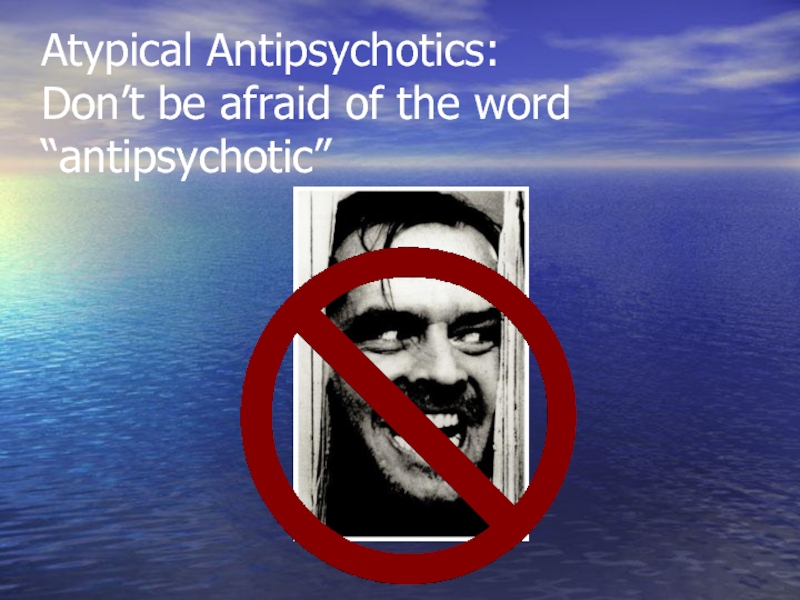
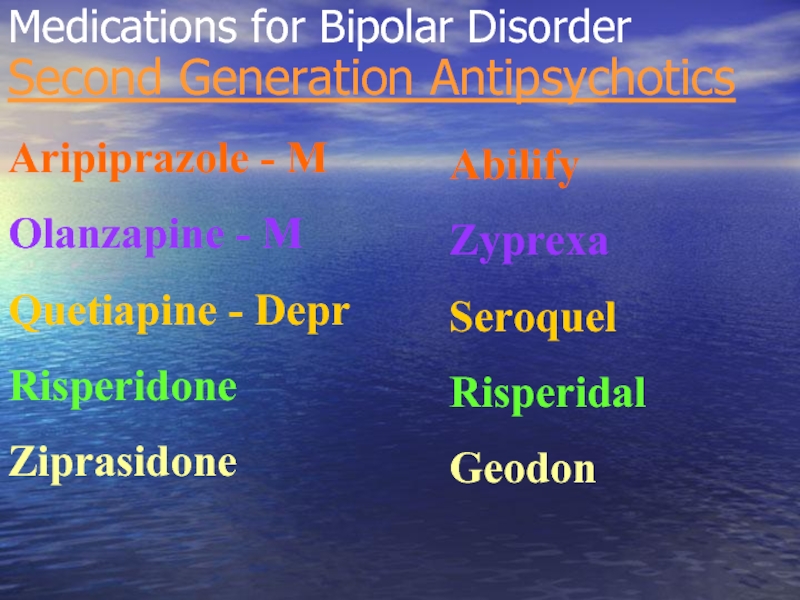
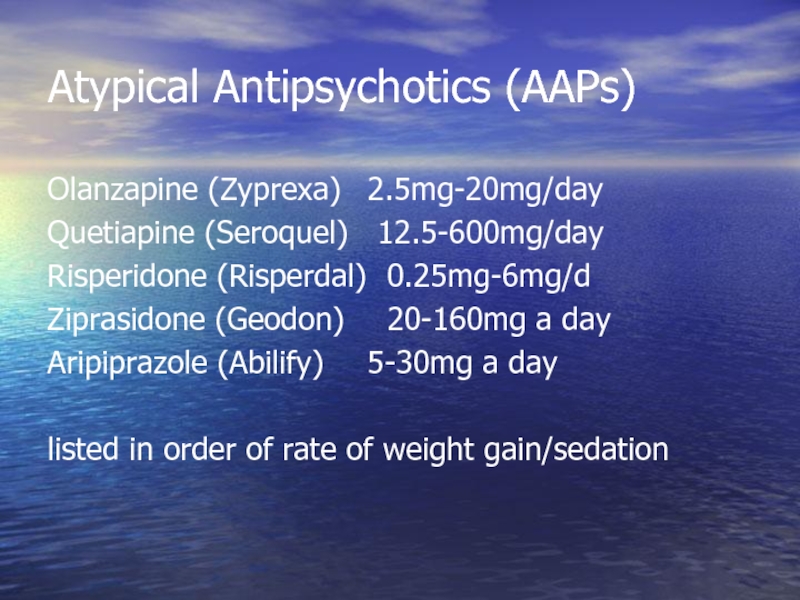
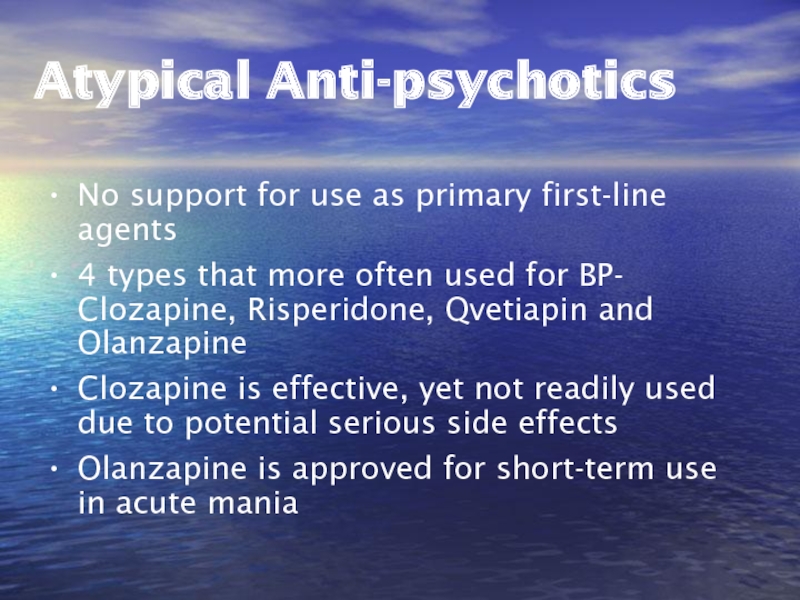
![ECT1] Mania very severe and not responding to medications.2] Patient prefers ECT3] Pregnant4] Psychotic signs](/img/tmb/2/163601/98c4eeee5515a47861320c51a956a004-800x.jpg)
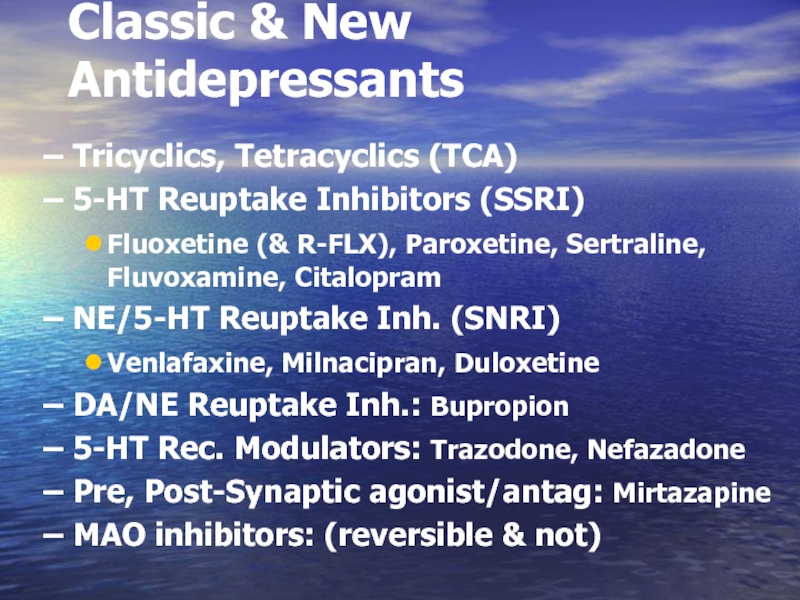
![SSRIs DosageFluoxetine [Prozac] 10-80 mg/dParoxetine [Paxil] 10-50 mg/dSertraline [Zoloft] 25-200 mg/dFluvoxamine [Luvox]](/img/tmb/2/163601/841609d336ffd18436c3a37e71072db0-800x.jpg)
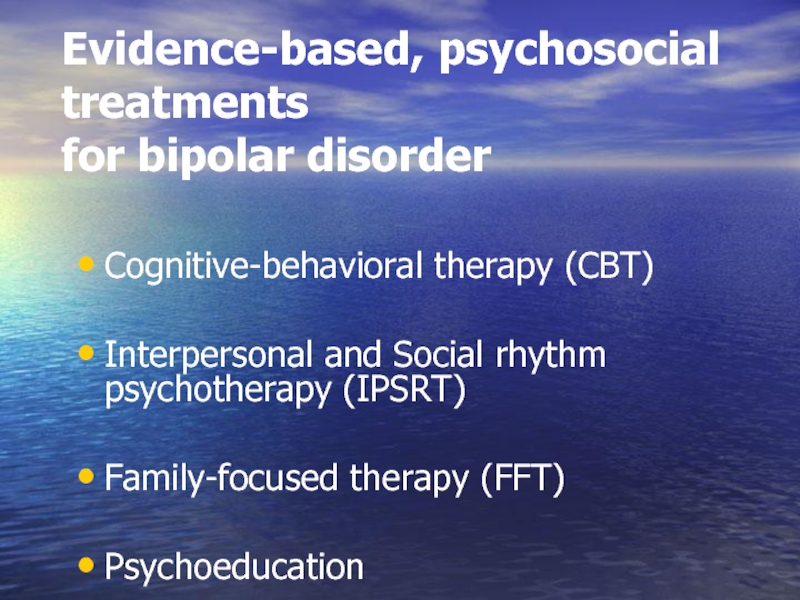
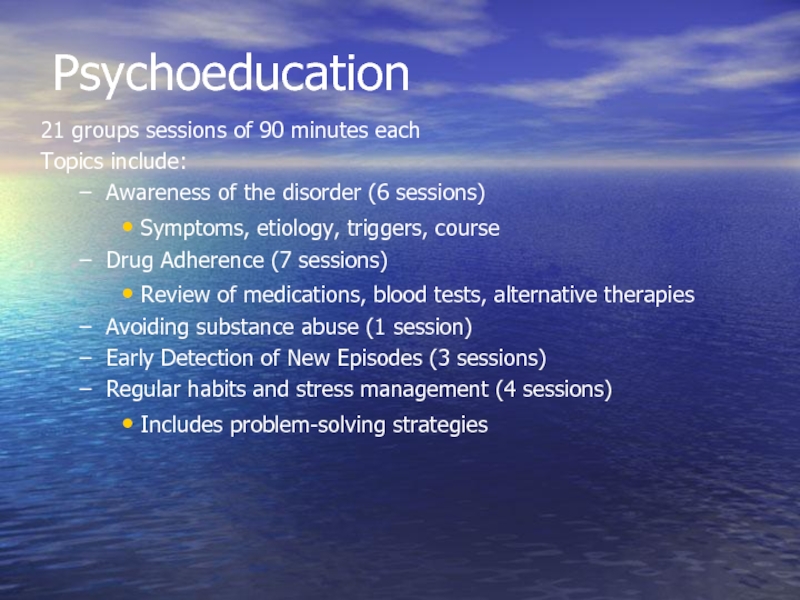
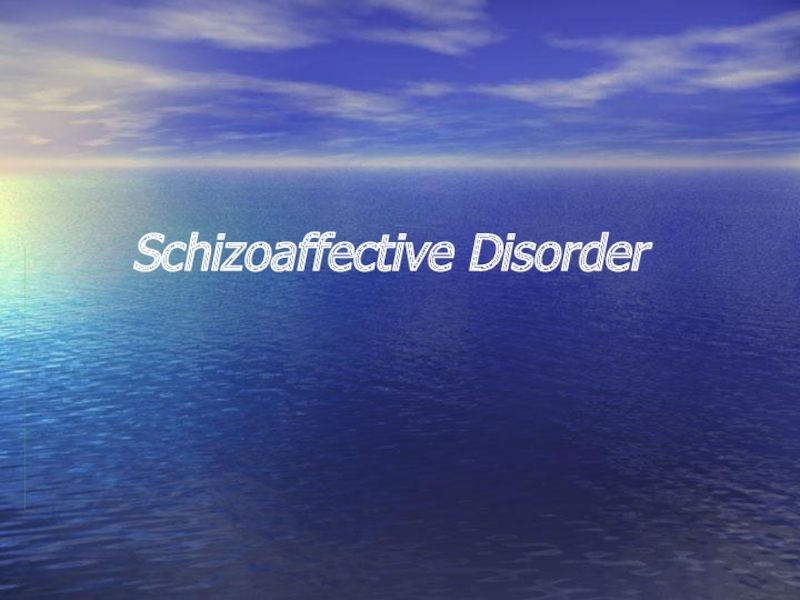
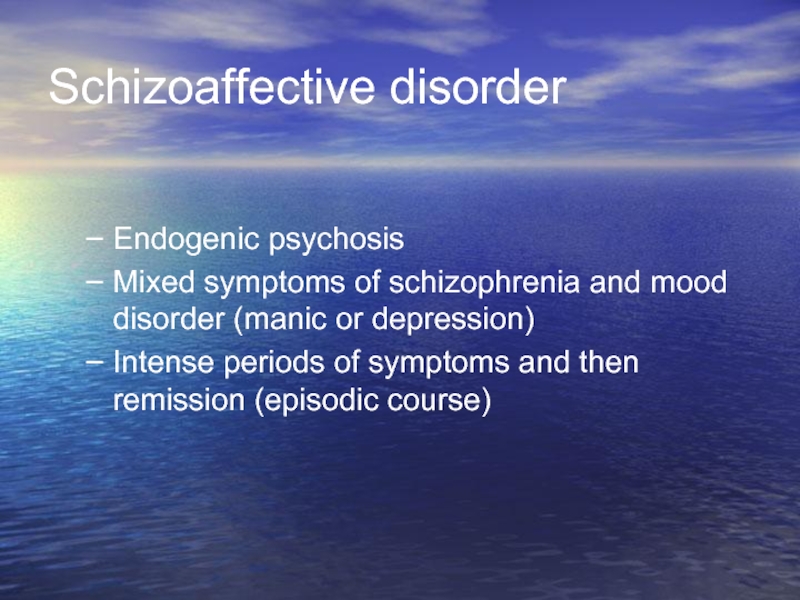
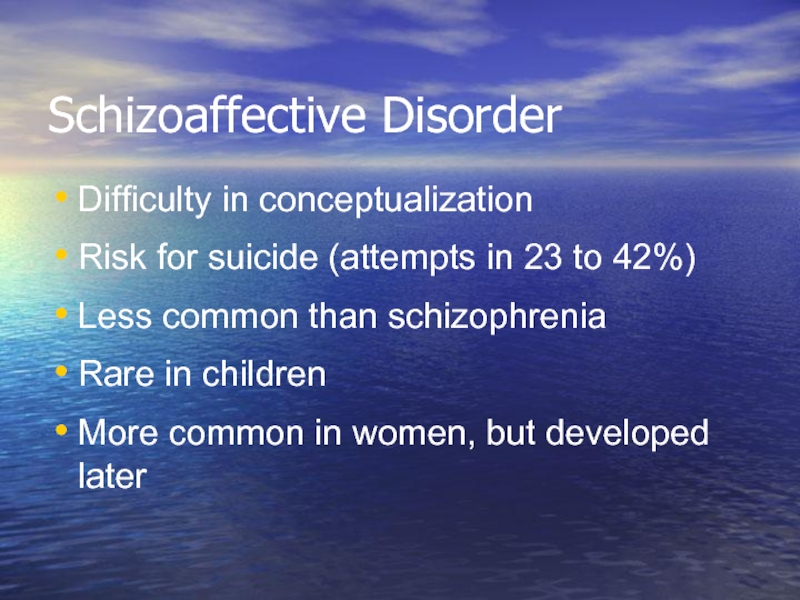
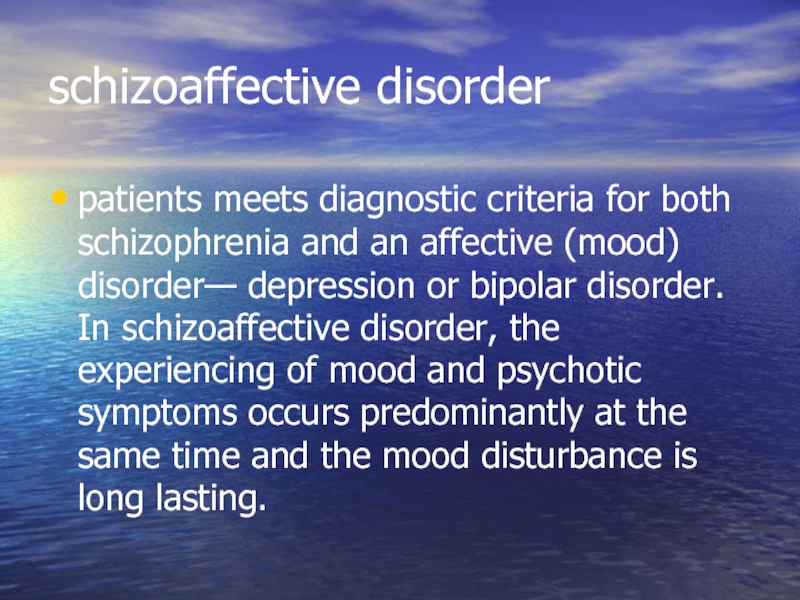
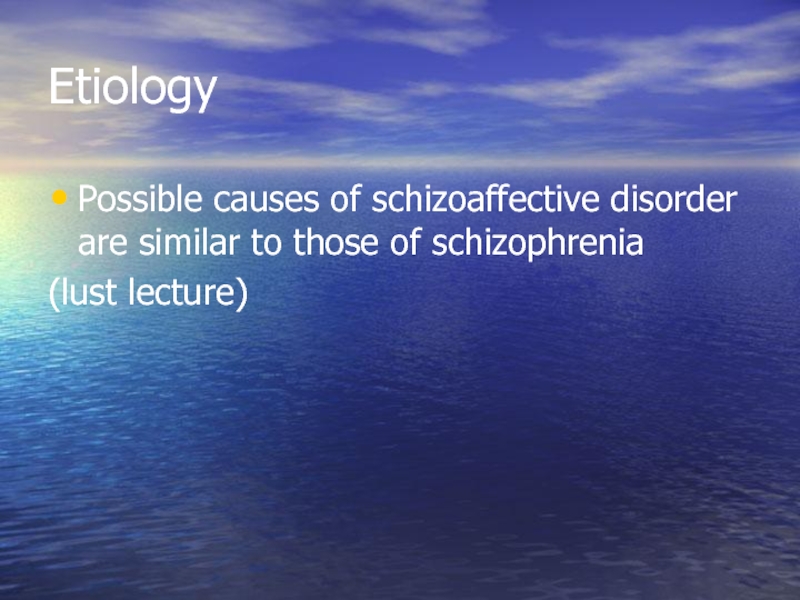
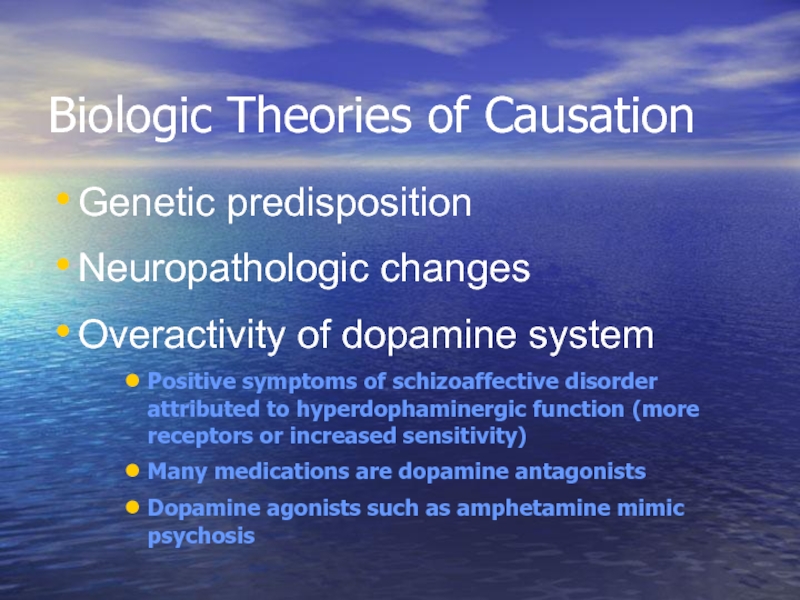
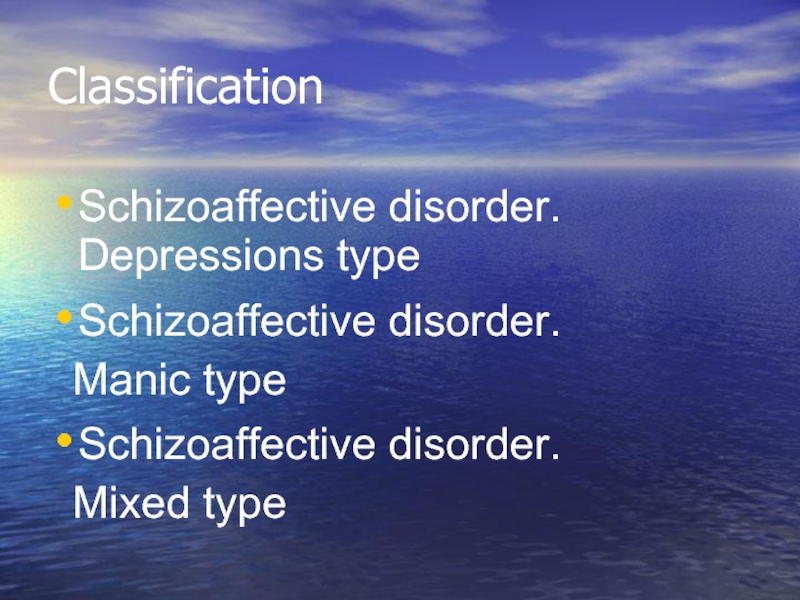
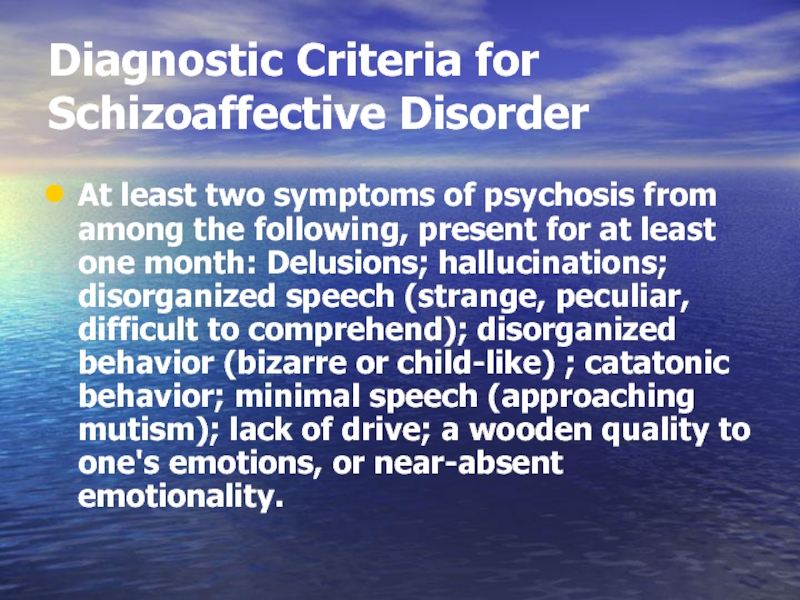
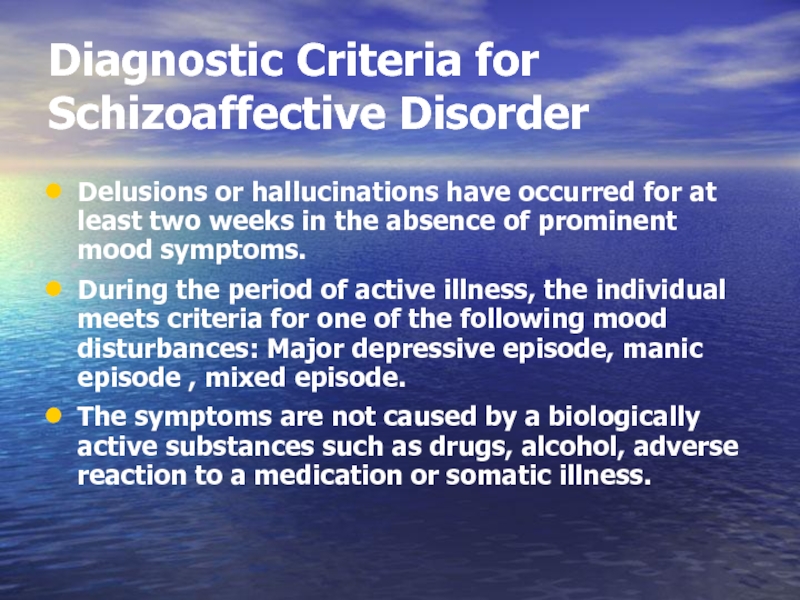
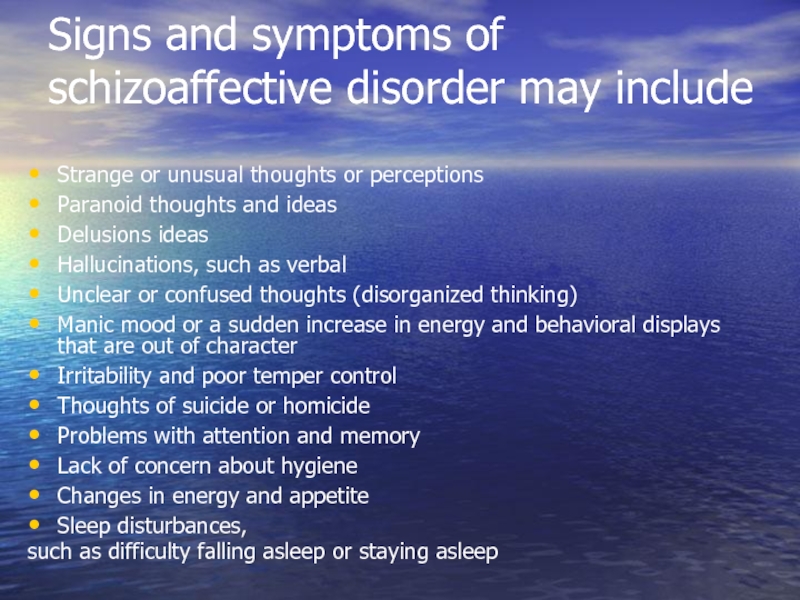
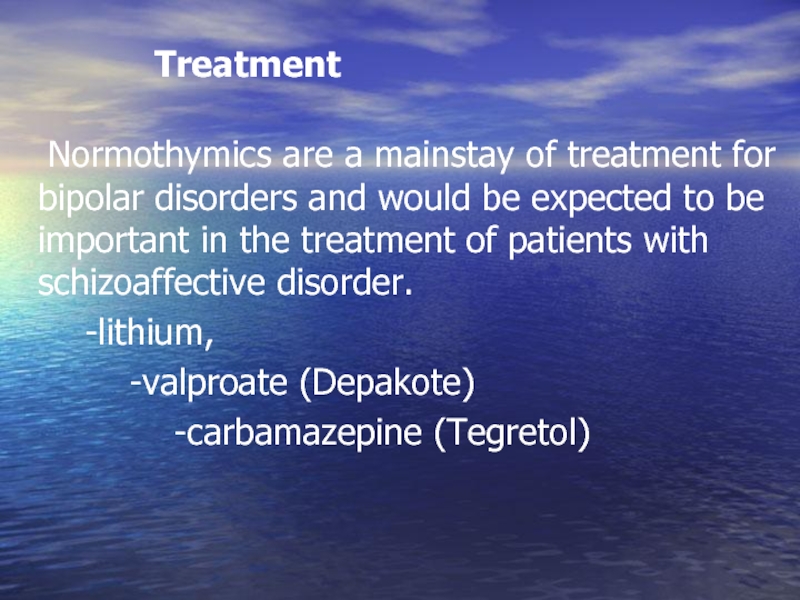
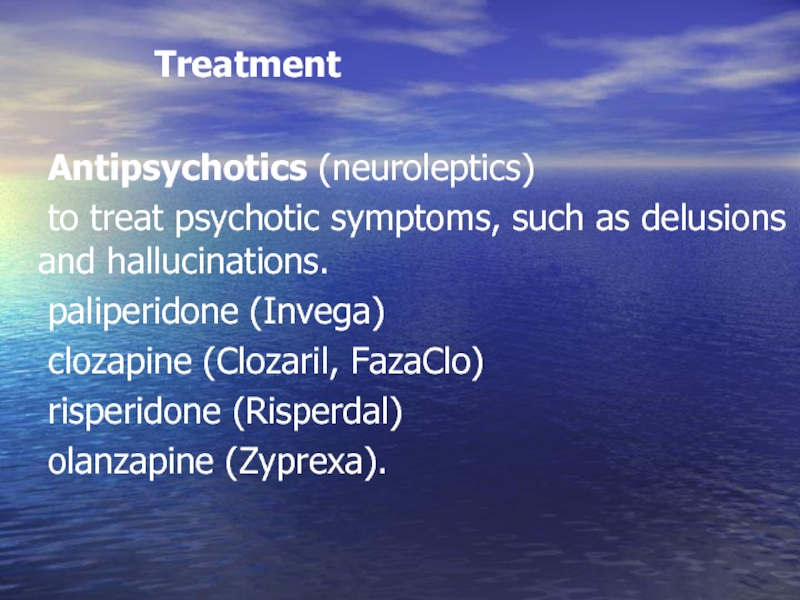
![Treatment Antidepressants. When depression is the main mood disorder, antidepressants Fluoxetine [Prozac] 10-80 mg/dParoxetine [Paxil]](/img/tmb/2/163601/0bee17993b258ef07b2251e8ea4a1ceb-800x.jpg)
